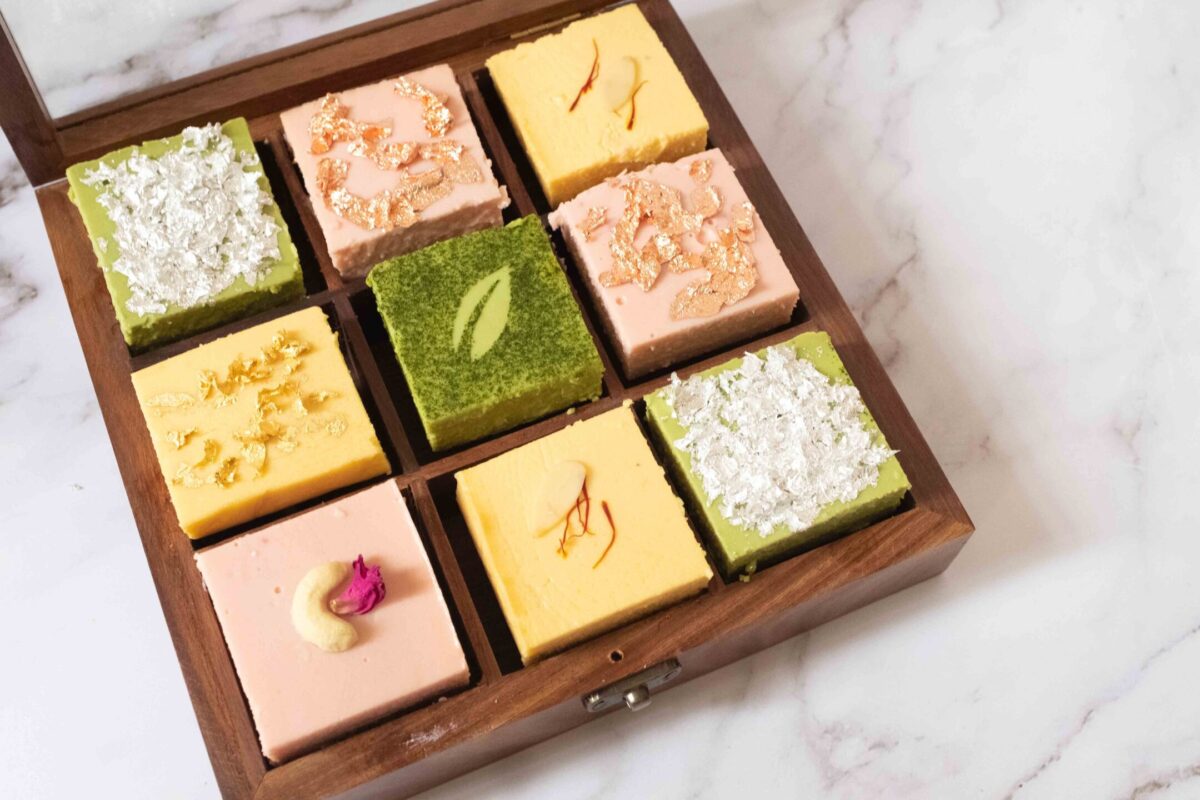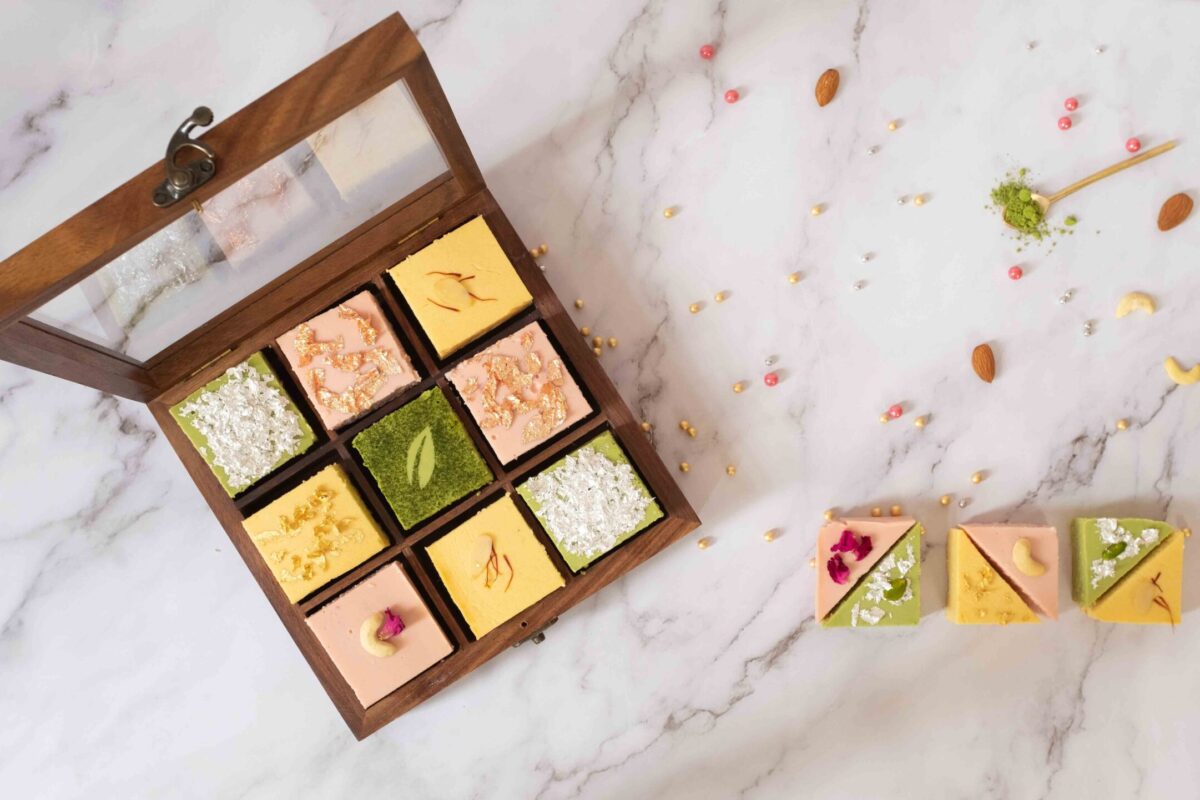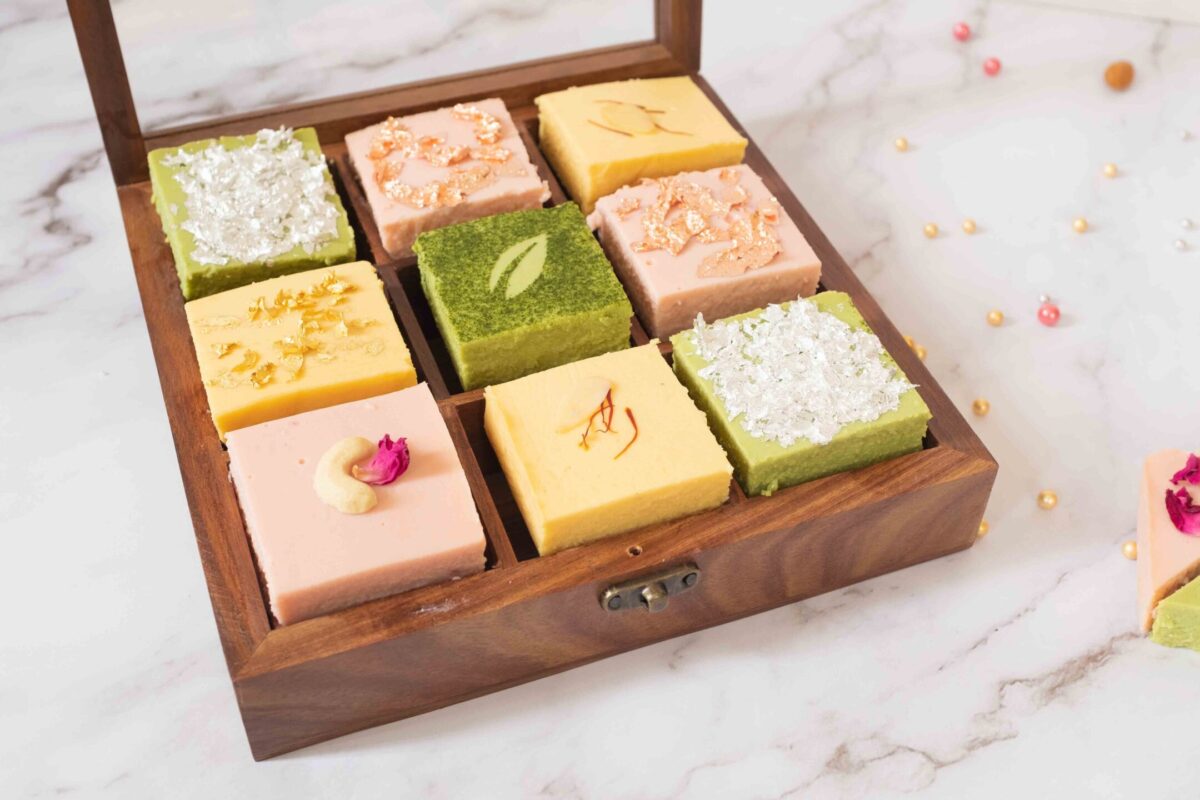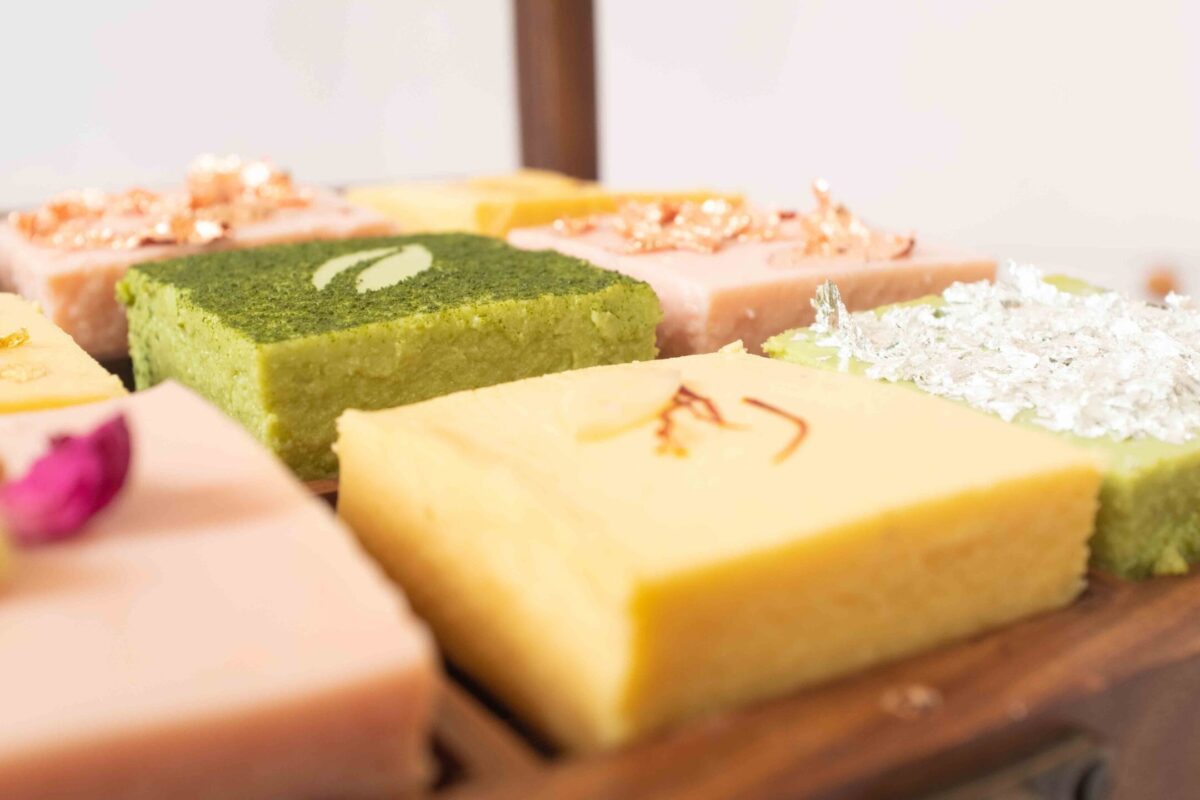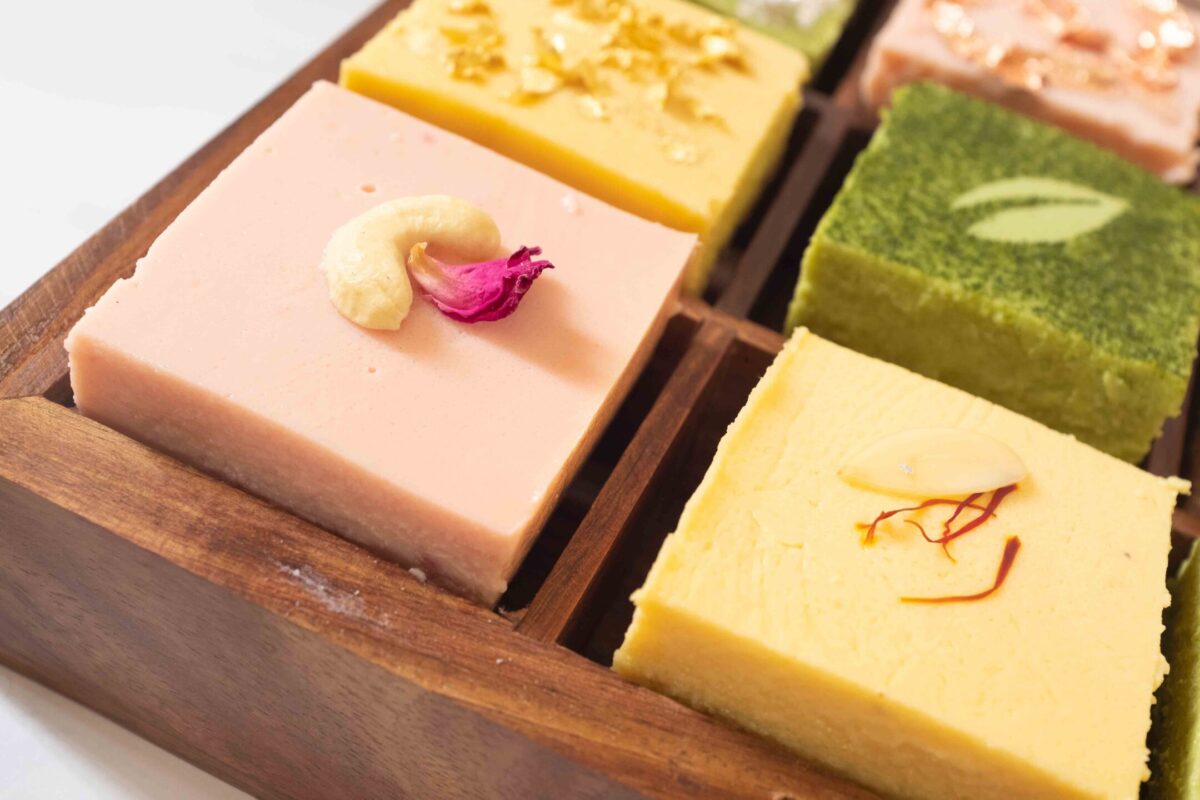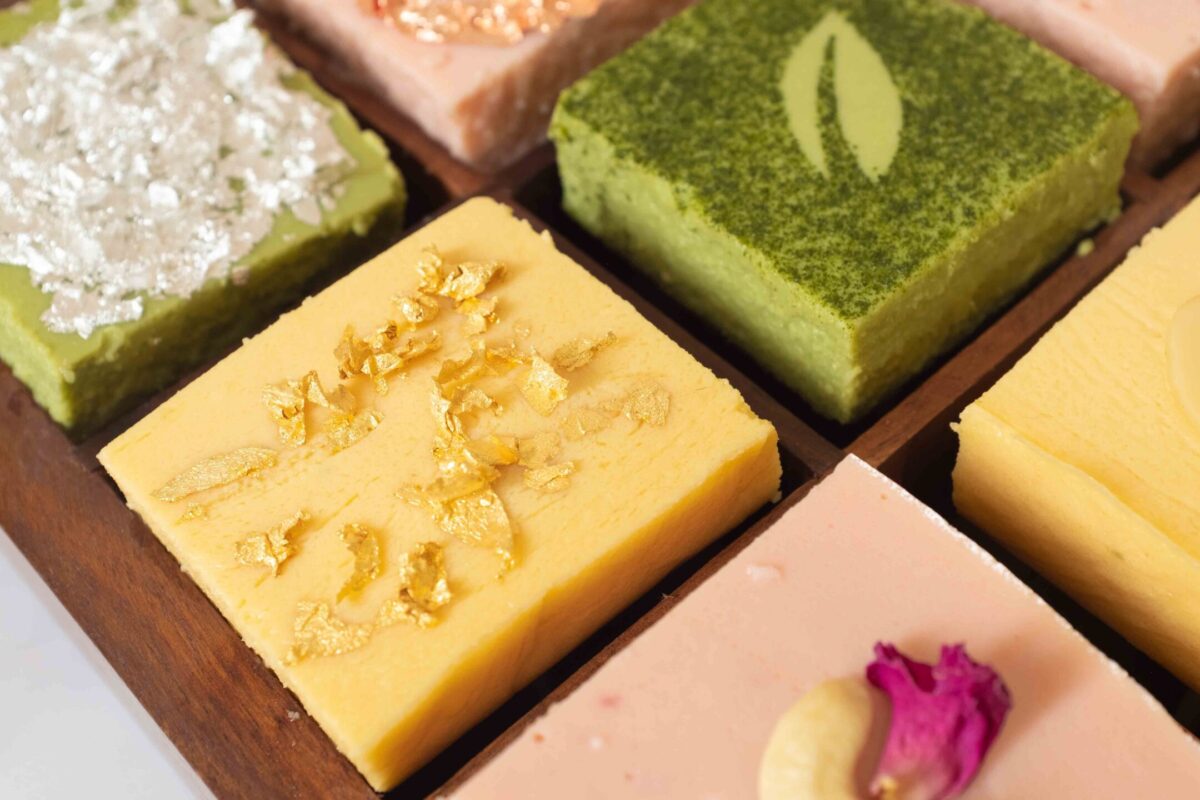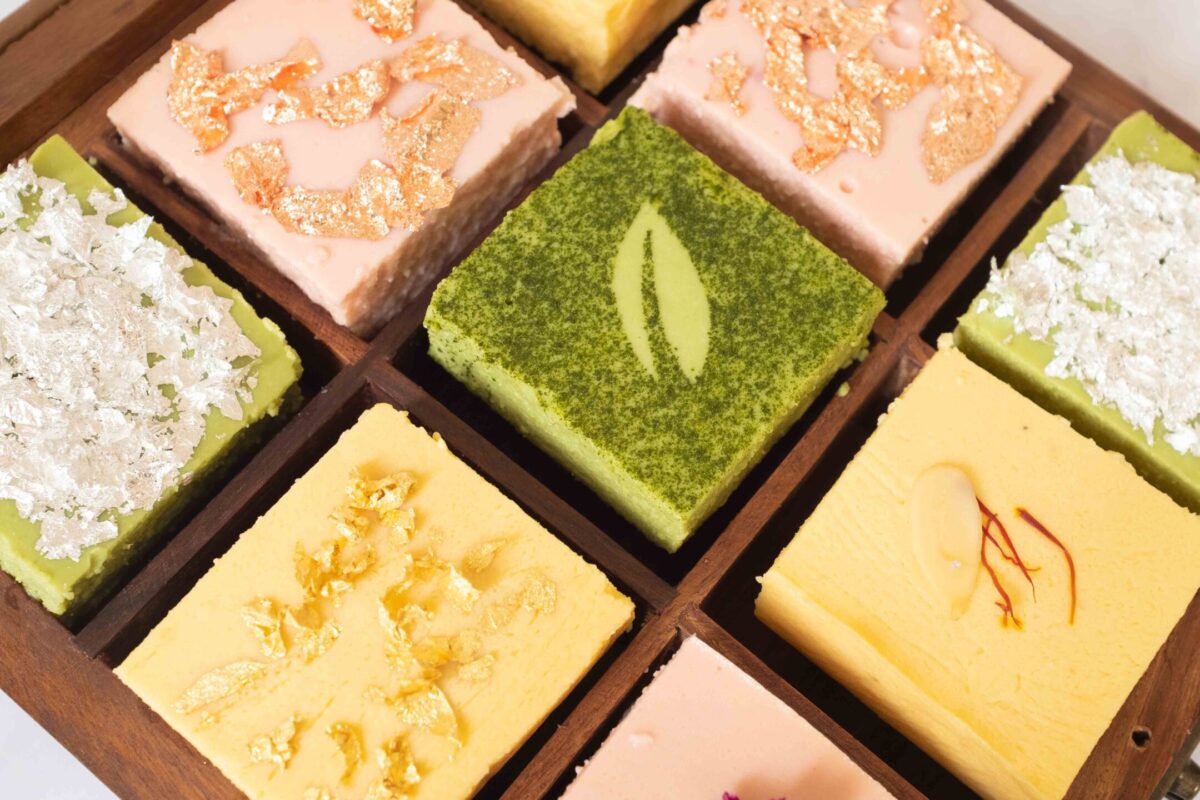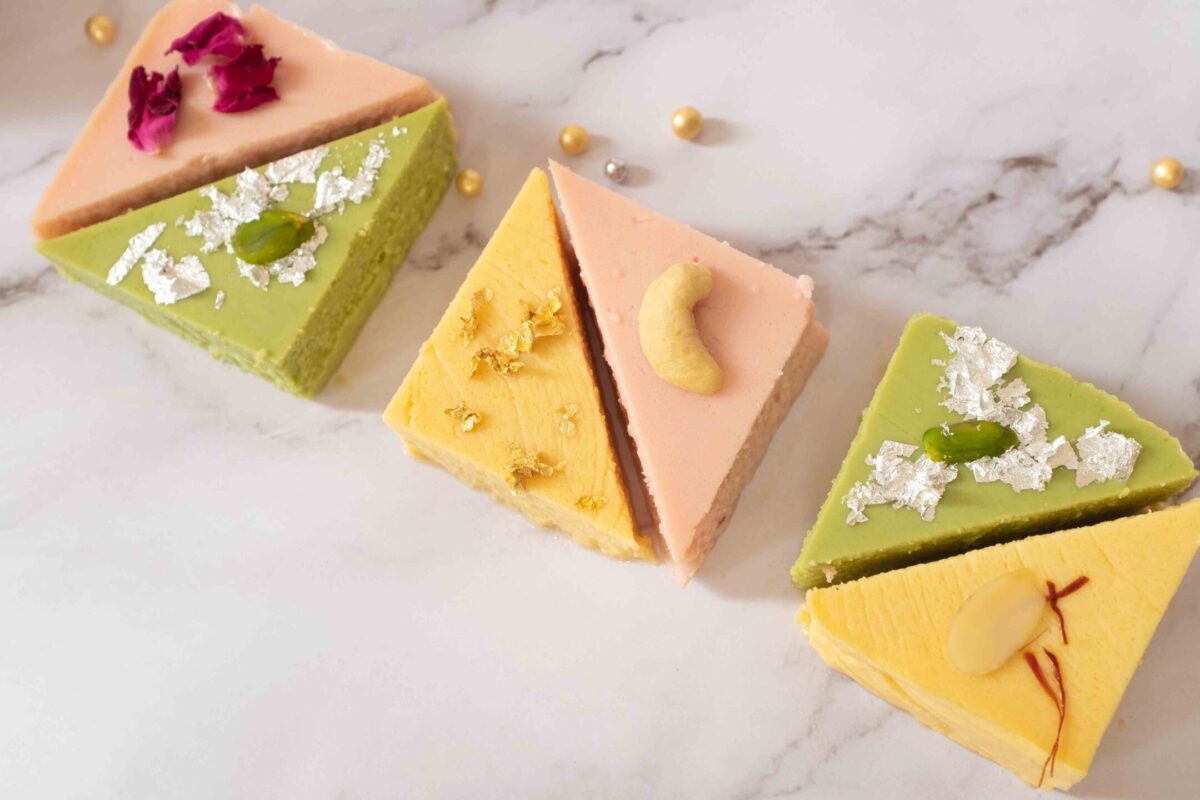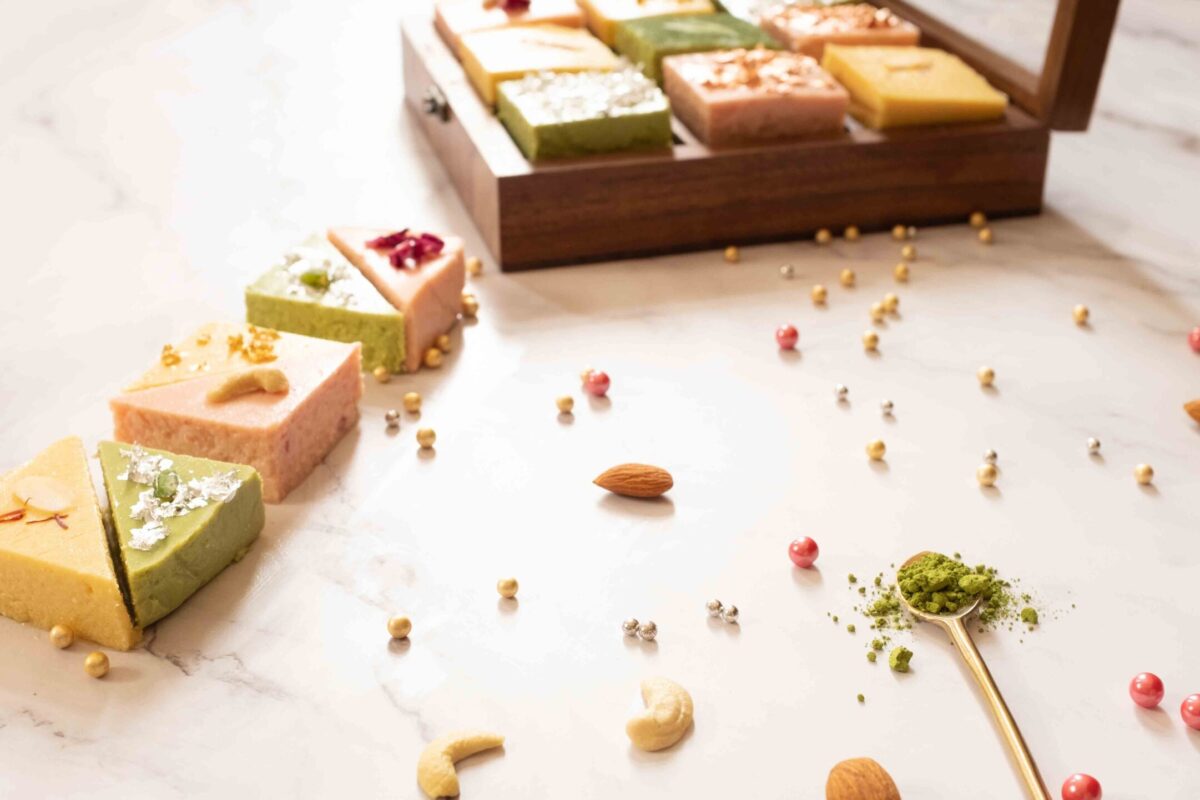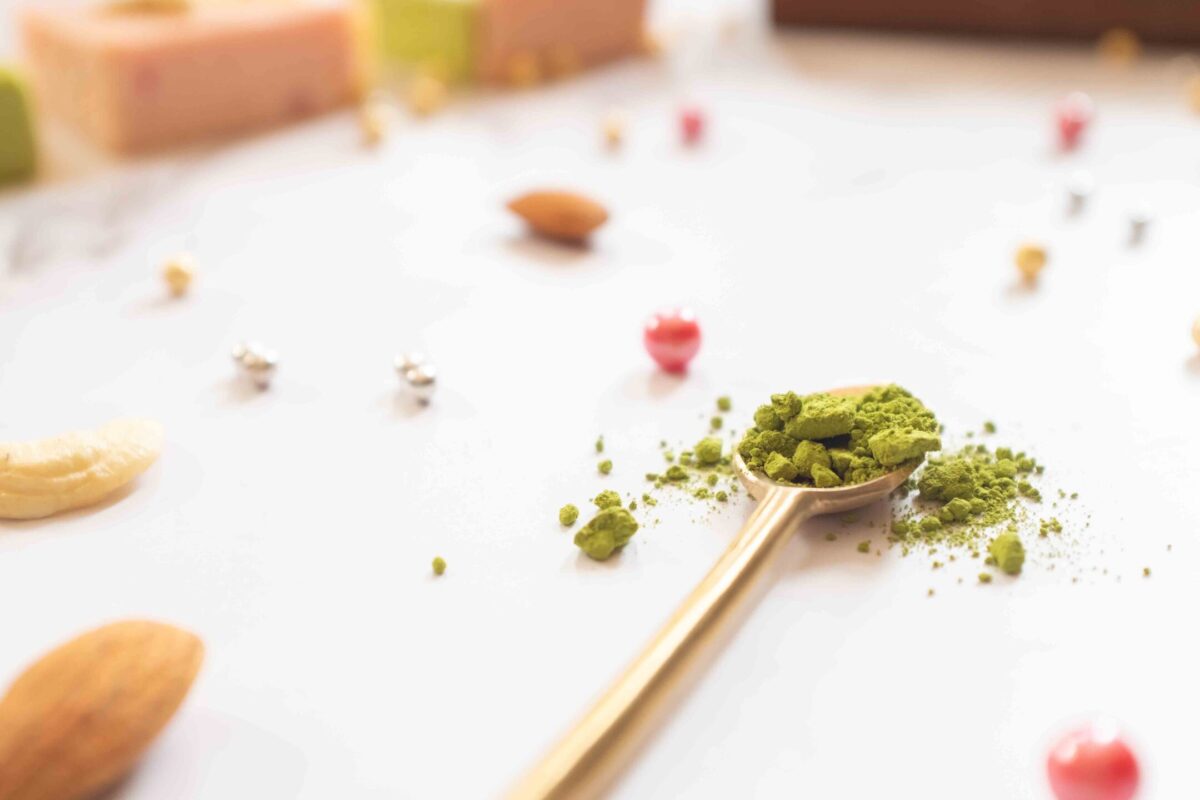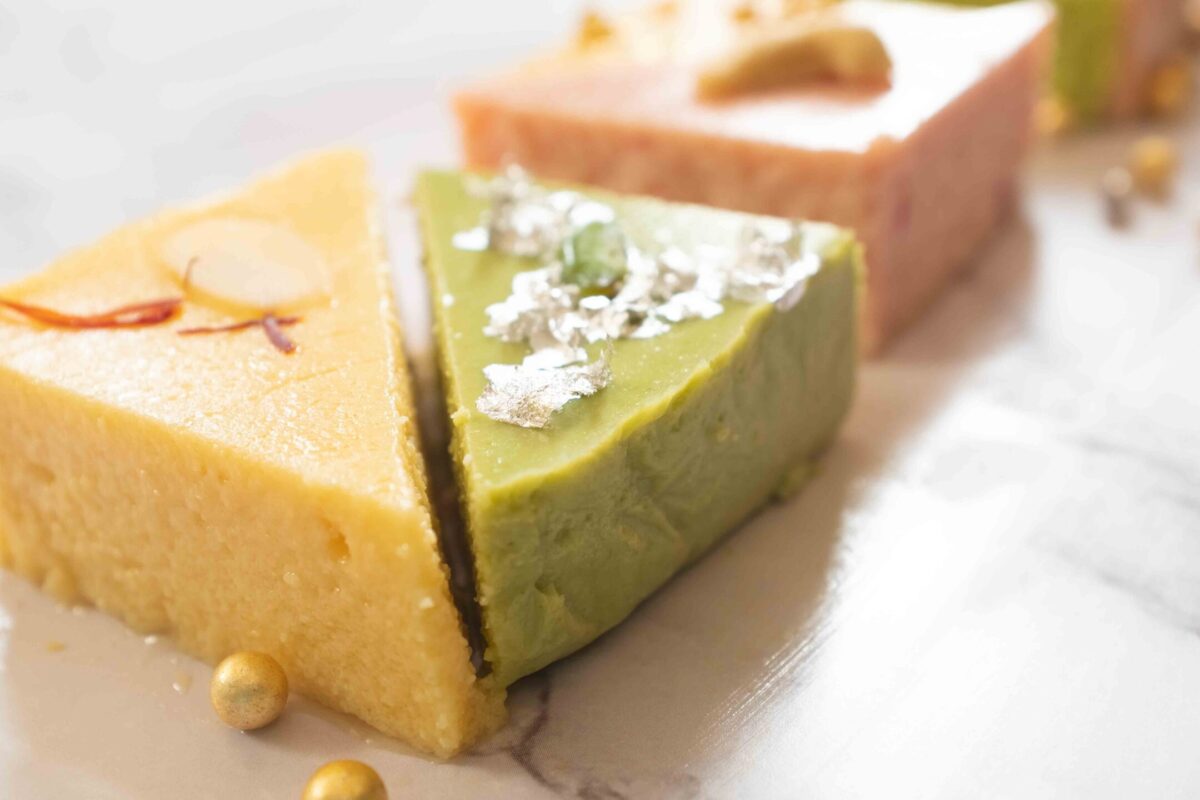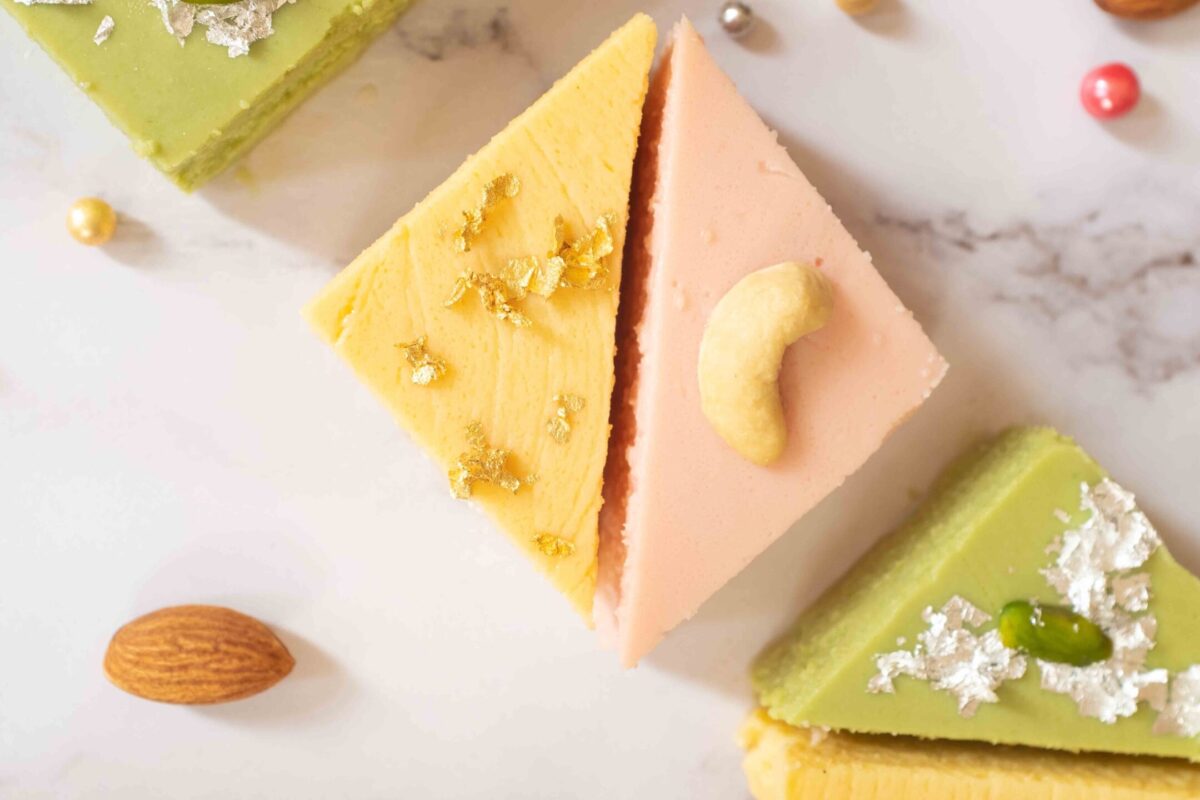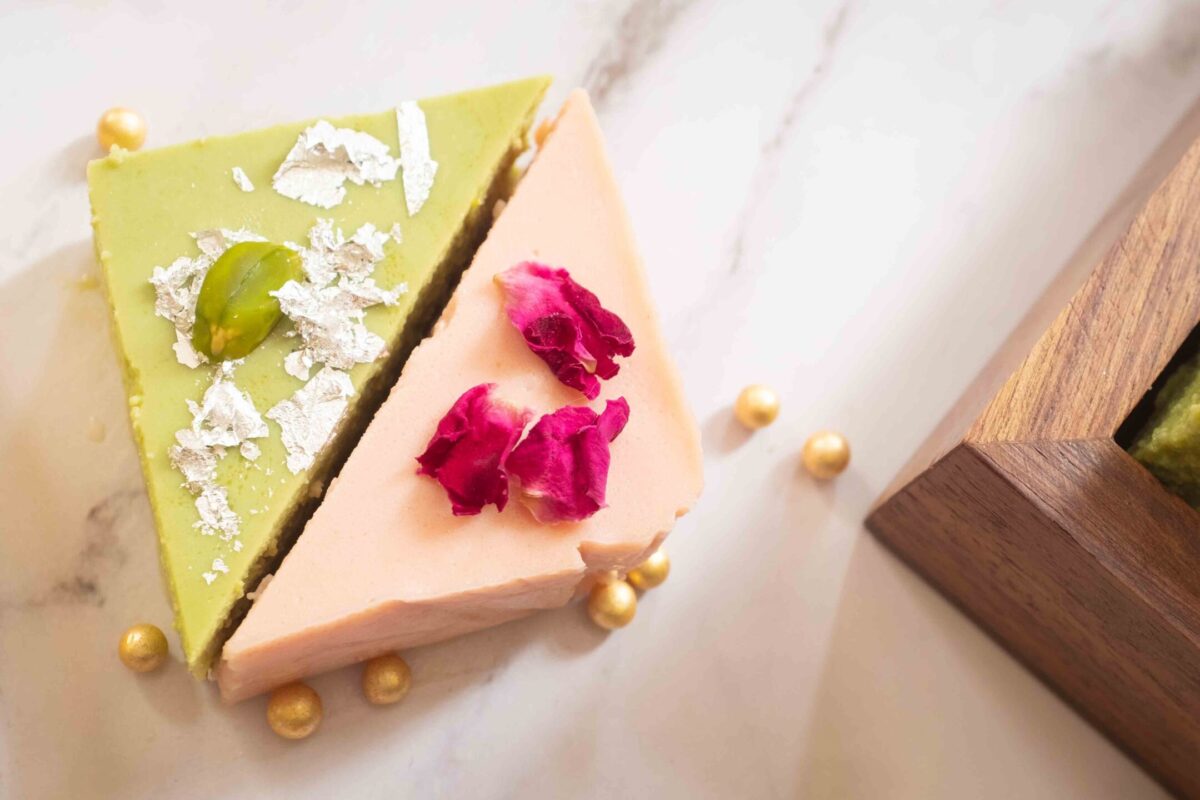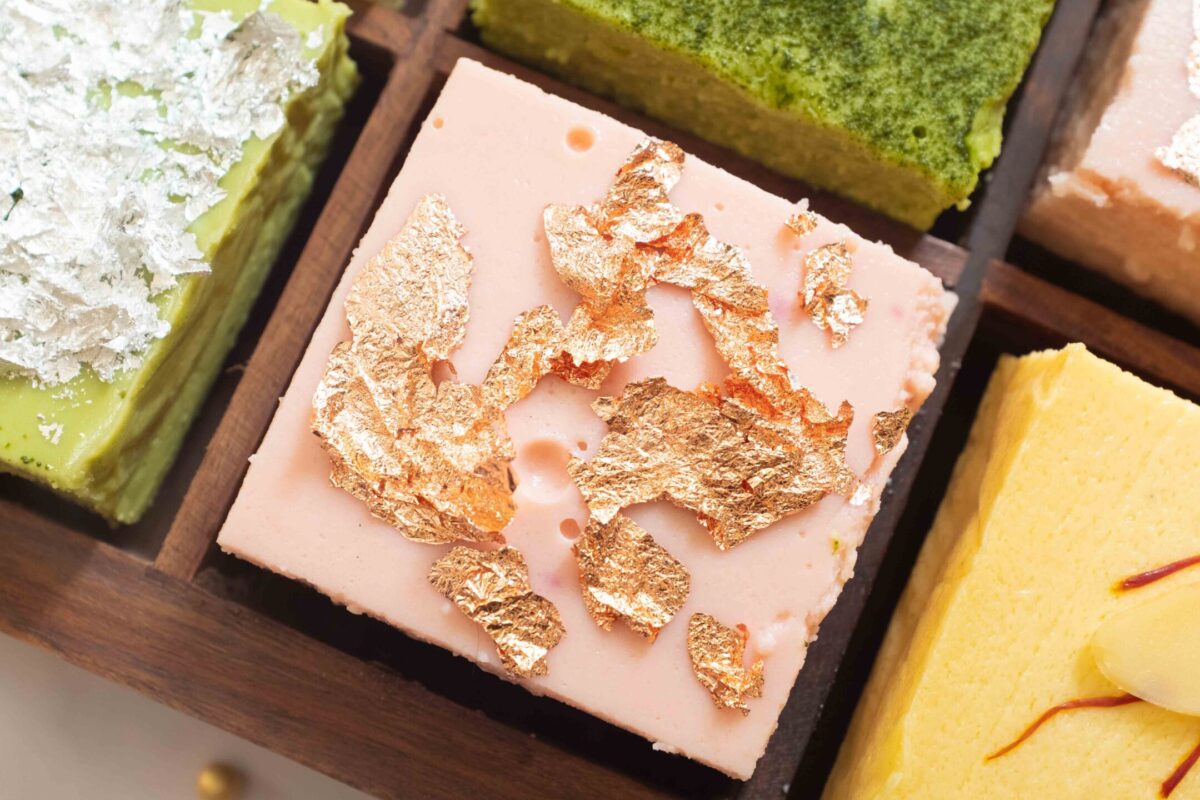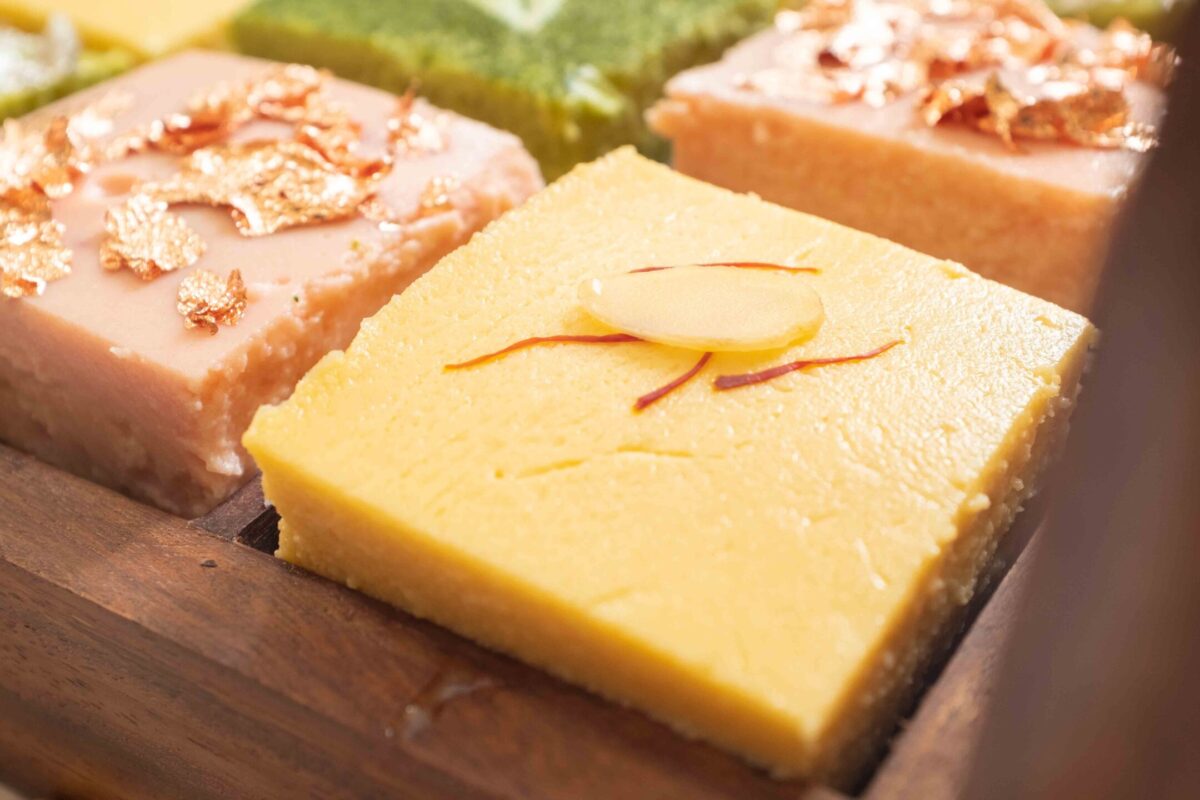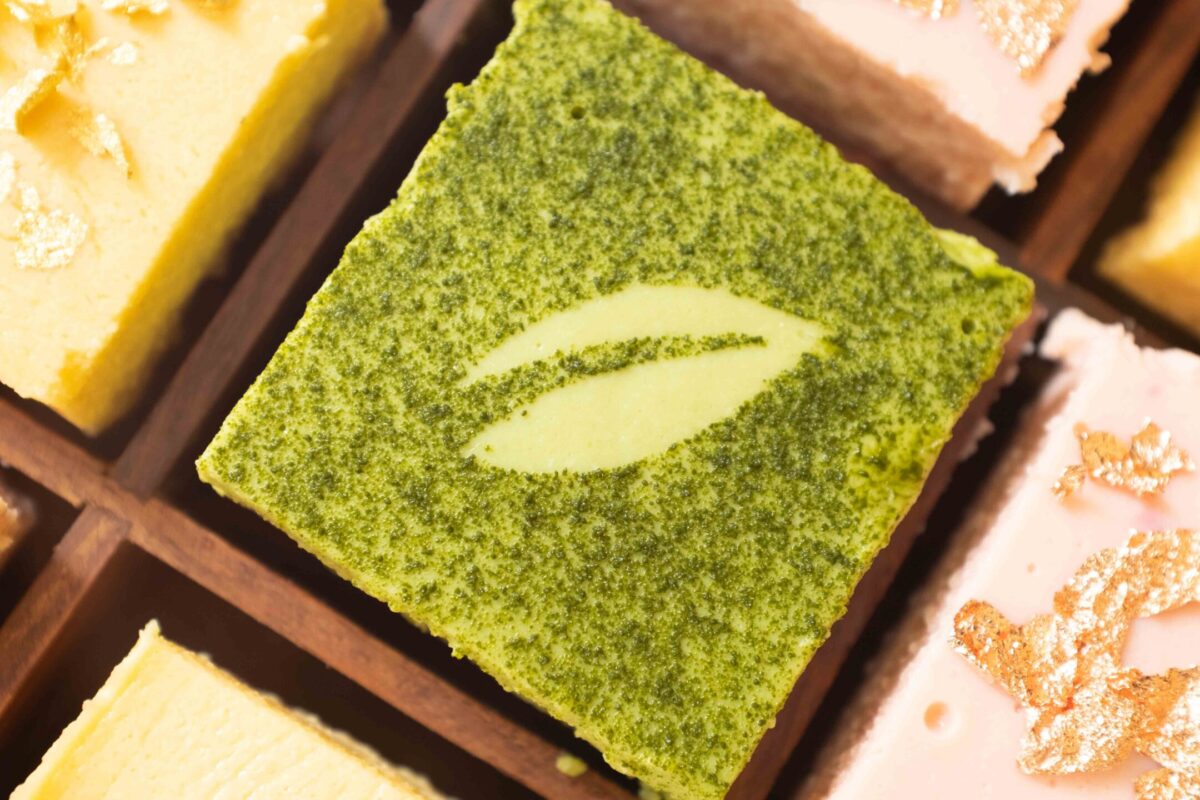Makes 96 servings (32 servings of each type)
Ice-cream Sondesh. Just the name gives me happy chills. Made with fresh cottage cheese that is steamed and then refrigerated, this sweet treat from Bengal is addictively soothing. Fun story—there’s no ice cream in ice-cream sondesh—it owes its name to the simple fact that it is served cold. For this recipe, I have made my two favourite ice-cream sondesh flavours—rose, and saffron—as well as a Japanese inspired Matcha one. Impossibly soft and mildly sweet, they will melt in your mouth and have you reaching for seconds and thirds…and fourths.
At a glance
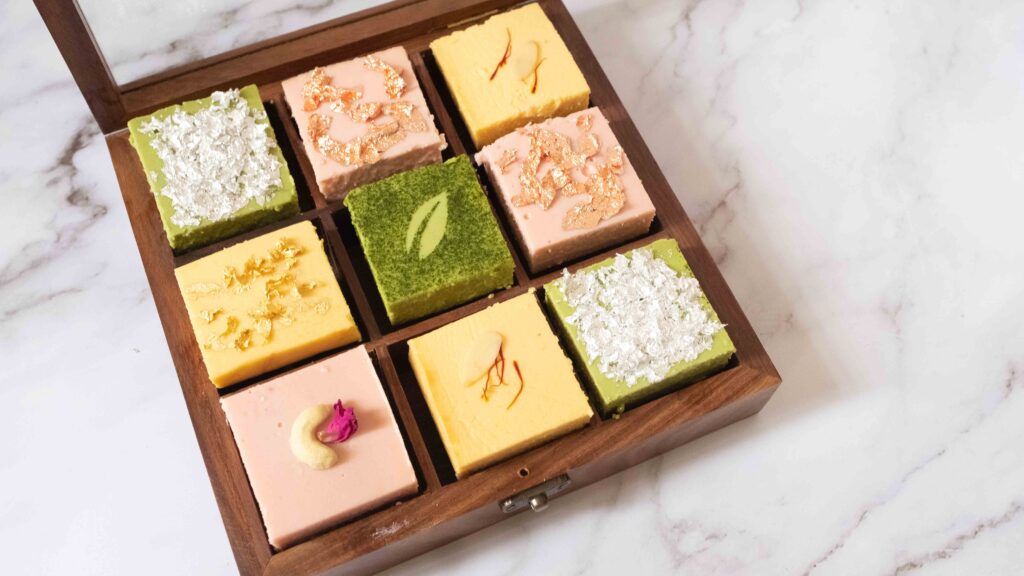
– This recipe comprises cottage cheese + rose-cashew ice-cream sondesh, saffron-almond ice-cream sondesh, & matcha-pista ice-cream sondesh.
– You will need a large cooking pot (4-5 litre), a stand blender, three 6-inch square cake pans and aluminium foil, a 4-5 litre steamer pot, and some trivets for steaming.
– This recipe has been broken into 2 stages for ease and comprehension. Please read the entire recipe from start to finish before beginning.
Stage 1: cottage cheese
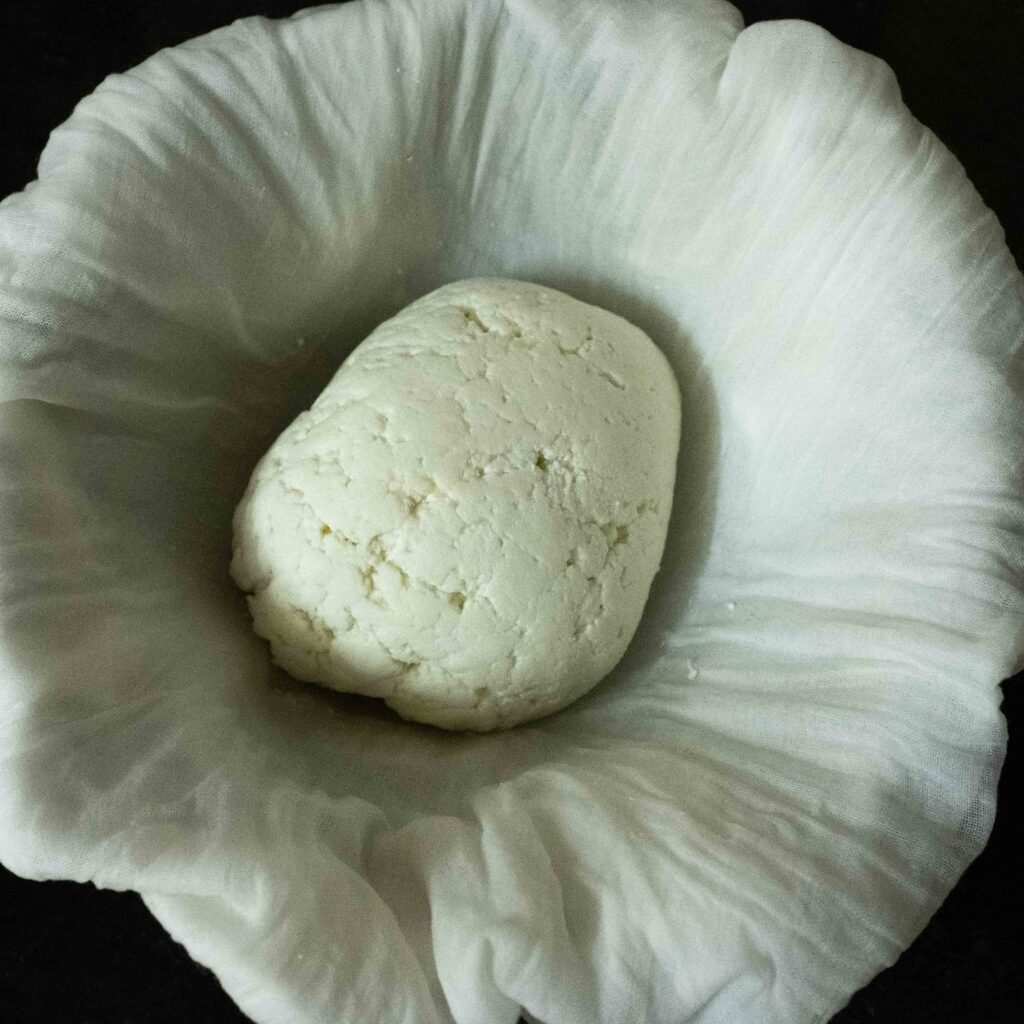
Homemade cottage cheese is much softer than store-bought paneer and is an essential component of this dessert. Readymade paneer simply won’t yield as soft a sondesh – so do go the extra mile and make this component from scratch.
Ingredients
1. 3 litres full fat, whole milk
2. 15 ml ghee (roughly 1 tbsp.)
3. 250 ml vinegar + 250 ml water
4. 250 ml plain water
Do not use low fat milk, homogenised milk, or UHT milk in this recipe. You must use full-fat whole milk, as anything else won’t yield enough cottage cheese curds.
Method
1 – Place the milk in a large cooking pot and bring it to a rolling boil, stirring occasionally to reincorporate the cream and fats. While the milk is heating up, line a strainer with some cheesecloth and place the strainer over a bowl.
2 – Once it comes to a boil, add the ghee and boil for an additional 20 seconds, stirring constantly.
3 – Turn off the heat and let the milk rest for 5 minutes to bring down the temperature.
4 – Add 250 ml water to the milk, and stir. This will bring the temperature of the milk down further.
5 – Dilute 250 ml (1 cup) white vinegar with 250 ml (1 cup) plain water.
6 – Add this diluted mixture to the milk, 60 ml (1/4 cup) at a time in 3-4 batches, stirring well and waiting for the curds to gradually coagulate between each addition. Stop adding the solution when the whey is no longer milky and becomes a clear, yellowish-green liquid. Keep in mind that you may or may not need to use all the solution, depending on the fat content of your milk. The higher the fat content, the more solution you will need. Reserve leftover solution to make future batches of cottage cheese.
7 – As soon as the curds have completely separated from the whey, transfer the contents of the pot to the muslin-lined strainer. Do not discard the whey collected in the bowl! It can be re-used to curdle milk, added to flour to make flatbreads and doughs, or even used as a cooking liquid for daals and pilafs. I used my leftover whey to make chhola’r daal.
8 – Lift the strainer up and carry it to your sink. Pour 1 litre plain water over the curds to gently rinse them. This will get rid of the vinegar smell and taste.
9 – Now lift the corners of the cheesecloth and twist to form a bundle. Do not squeeze the bundle, simply twist and allow the whey to strain out naturally.
10 – Suspend the bundle of cottage cheese from a height so that the whey can drip out naturally for 6 hours.
11 – After 6 hours, all of the whey will have dripped away, leaving you with a very soft textured and dry cottage cheese that is perfect for using to make Bengali cottage-cheese based desserts from rossogolla to sondesh. Simply untie the bundle and use in this recipe as directed. I got 600 gm from 3 litres milk. You might get more or less.
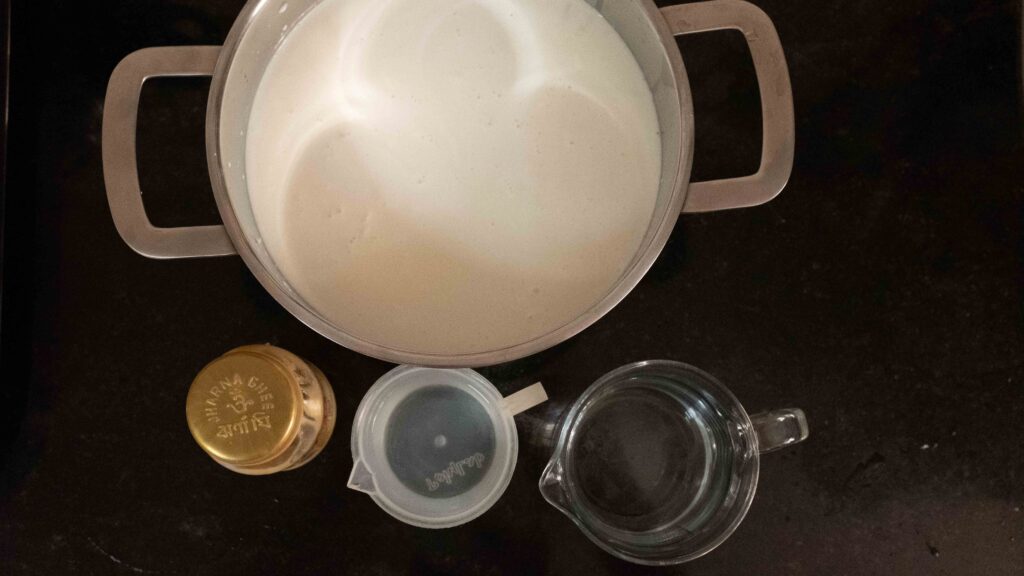
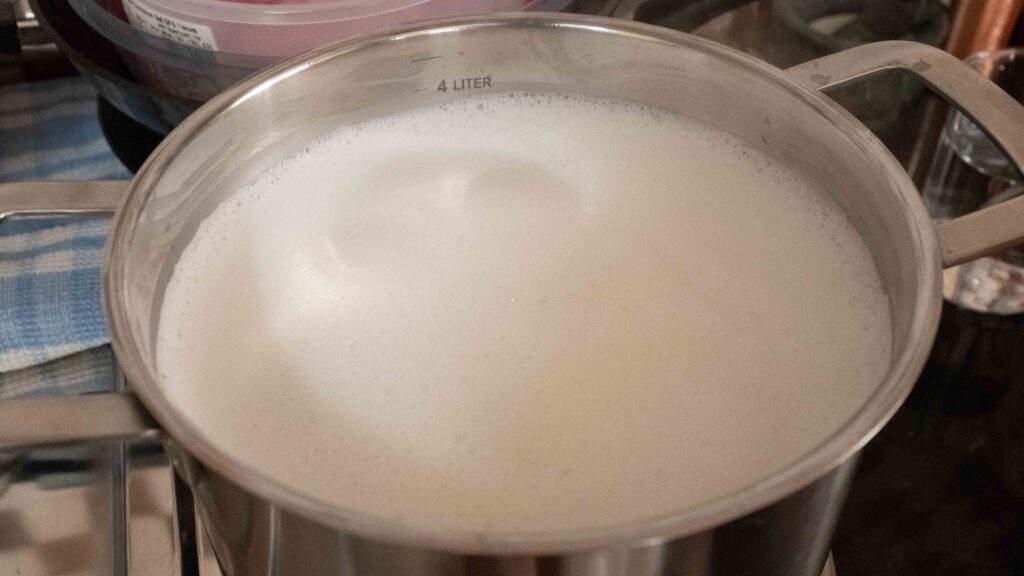
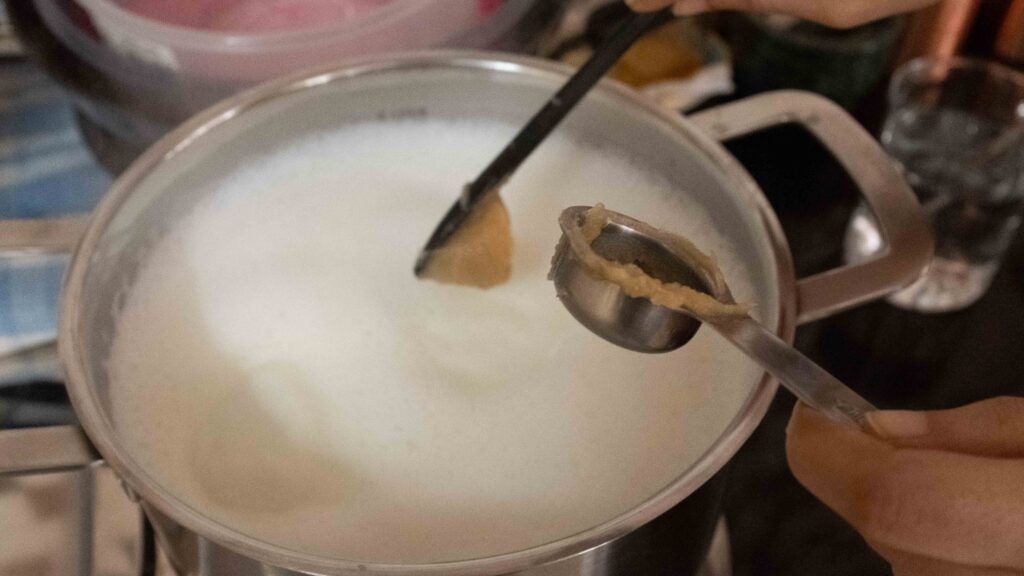
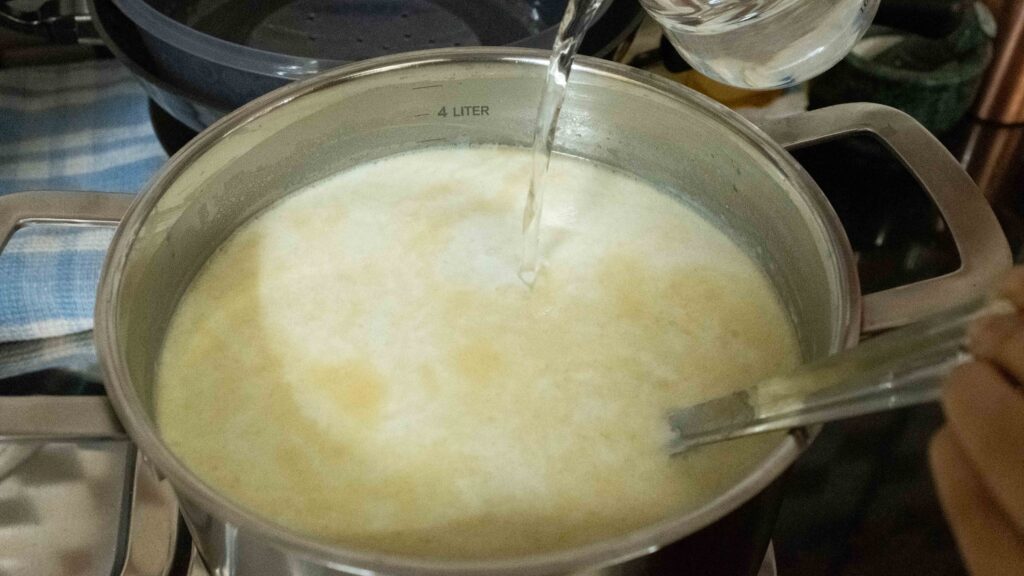
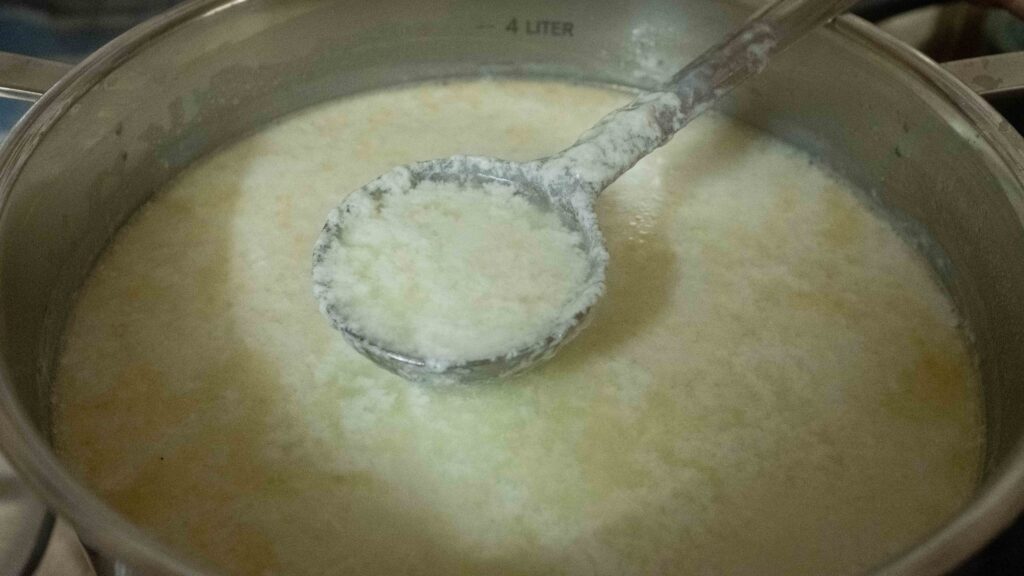
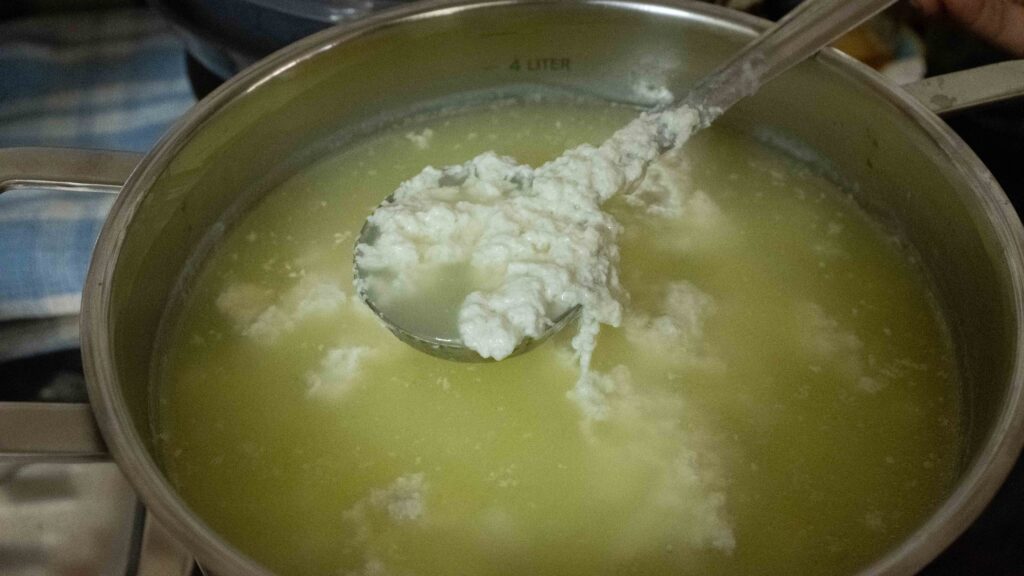
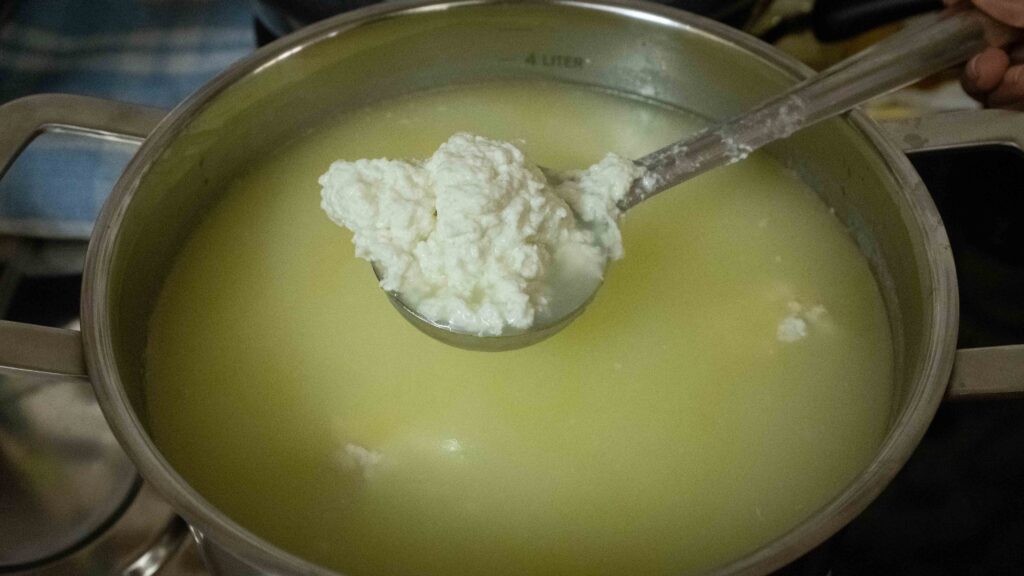
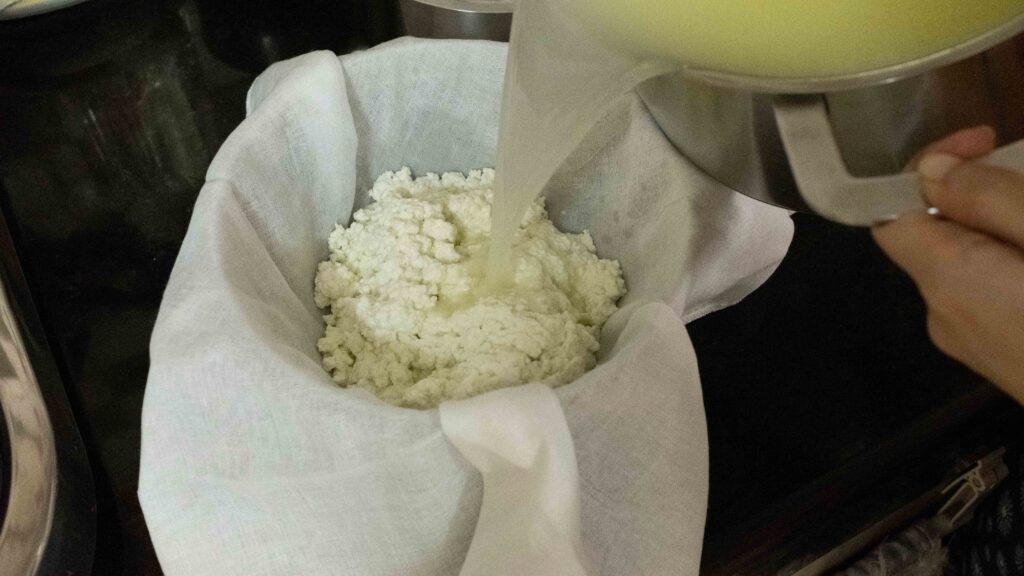
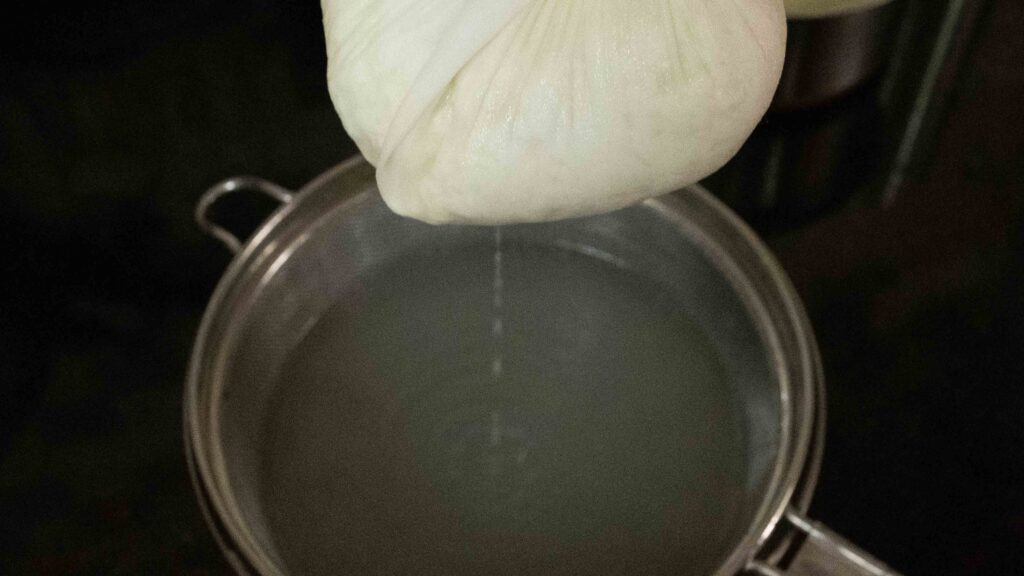
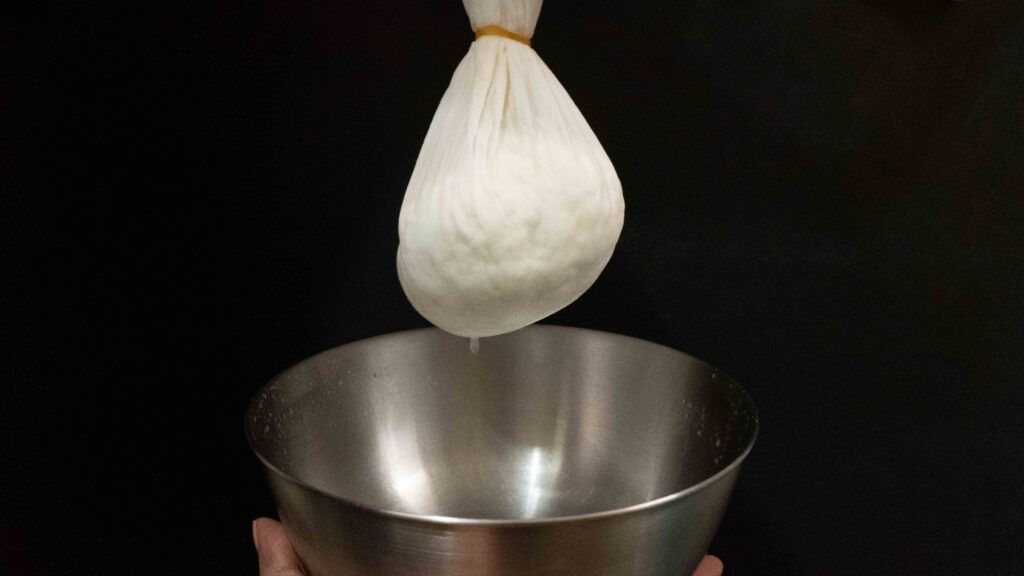
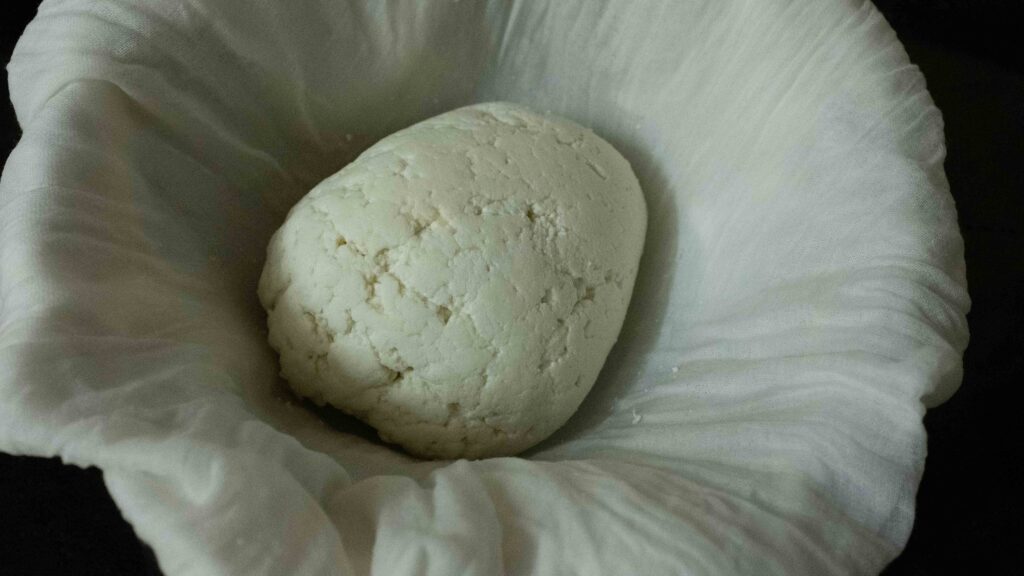
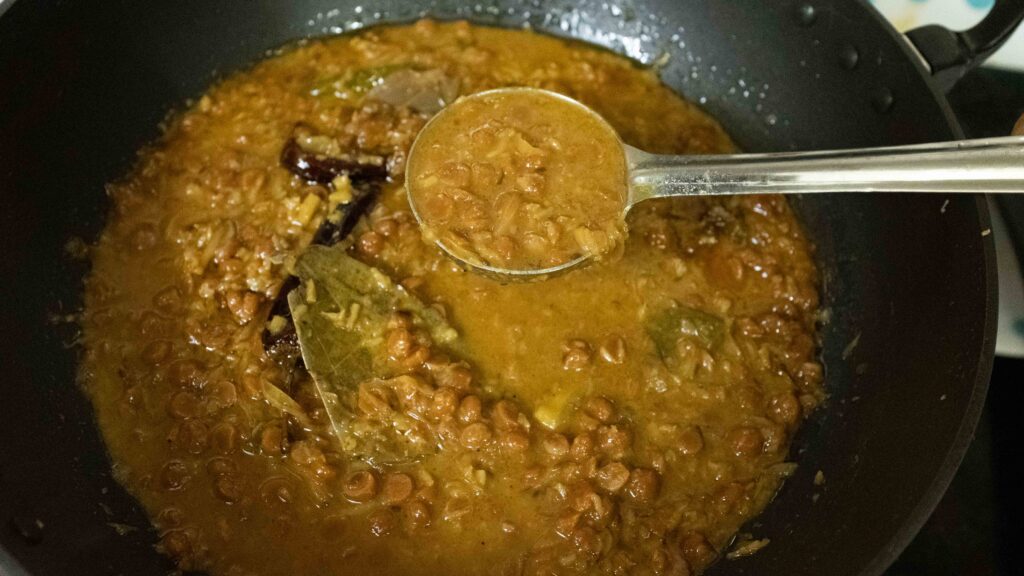
There are multiple ways to make cottage cheese and each method has its pros and cons. You basically need an acidic agent that will gently curdle the milk. The higher the fat, the greater the amount of acid you will need to curdle the milk. When you make cottage cheese from whole milk, the exact fat percentage of the milk is unknown, so the amount of acid you have to add will vary with each batch of milk. Some recommend using freshly squeezed lemon juice or plain curd (dahi/tok doi) instead of white vinegar. Lemon juice yields softer curds than vinegar. But, if you use lemon juice, you have to squeeze and strain the juice. If your milk doesn’t sufficiently curdle, you’ll have to squeeze some more lemons. On the flip side, too much lemon juice can make the curds grainy and gritty, so it can be unpredictable to work with. Using plain curd is supposed to yield the softest cottage cheese, but once again, the amount you need to curdle your milk will vary depending on the amount of milk and the fat content of the milk. Plus, it’s a waste of perfectly good curd! I prefer using a vinegar-water solution because it’s a cheap and convenient acidic agent to have on hand. It allows for a very controlled, gentle curdling, which results in large, soft curds, every time. When using vinegar, keep the following things in mind. Do not add undiluted vinegar, as it is very acidic and results in tough curds. Do not use flavoured vinegar as its taste will infuse into the cottage cheese. Finally, let the milk cool down a little before you curdle it; if you add the vinegar solution while the milk is still boiling or it’s too hot, you will get a harder-textured cottage cheese which will compromise the softness of the final dish.
Stage 2: rose-cashew ice-cream sondesh, saffron-almond ice-cream sondesh, & matcha-pista ice-cream sondesh
I made these three flavours—because I remember the first two most fondly from my childhood, and the third is a personal experiment (and I love matcha). You could keep the sondesh plain, or even switch things around by adding cocoa powder, date palm jaggery (gur), strawberry syrup, or mango syrup. You do you!
Ingredients
for the rose-cashew sondesh:
1. 1/3 the cottage cheese (200 gm)
2. 15 gm raw cashews (8-10)
3. 125 ml heavy or whipping cream
4. 125 ml sweetened condensed milk
5. 30 ml rose syrup like this (roughly 2 tbsp)
6. Optional; 1 drop pink food colour like this
7. Optional; 8 Rose petals for topping or edible rose gold flakes like this
for the saffron-almond sondesh:
1. 1/3 the cottage cheese (200gm)
2. 15 gm blanched and skinned almonds (14-15)
3. 125 ml heavy or whipping cream
4. 125 ml sweetened condensed milk
5. 15 ml warm milk + 10 strands of saffron
6. 1/16 tsp cardamom powder
7. Optional; 5-6 drops saffron yellow food colour like this
8. Optional; 8-16 saffron strands and finely sliced almonds for topping, or edible gold flakes like this
for the matcha-pista sondesh:
1. 1/3 the cottage cheese (200 gm)
2. 15 gm blanched and skinned pistachios (30-32)
3. 125 ml heavy whipping cream
4. 125 ml sweetened condensed milk
5. 15 ml warm milk + 2 tsp matcha like this
6. Optional; matcha powder for dusting and finely chopped blanched pistachios for topping, or edible silver flakes like this
to steam the sondesh:
1. 1/4 tsp ghee per mould, for greasing
2. 1-2 litre plain water per pot, for steaming
If you don’t get 600 gm cottage cheese from 3 litres of milk, and you’re in a pinch, buy some soft fresh readymade cottage cheese (paneer) like this. Weigh out how much you need to make up 600 gm total, and then finely grate that portion with a cheese grater (small holes). Don’t have blanched almonds? Watch this video on how to blanch almonds at home. If you don’t know how to skin pistachios, check out this post.
Prep
1 – Line all your baking pans with two layers of aluminium foil. Then lightly grease each mould with ghee. Set aside.
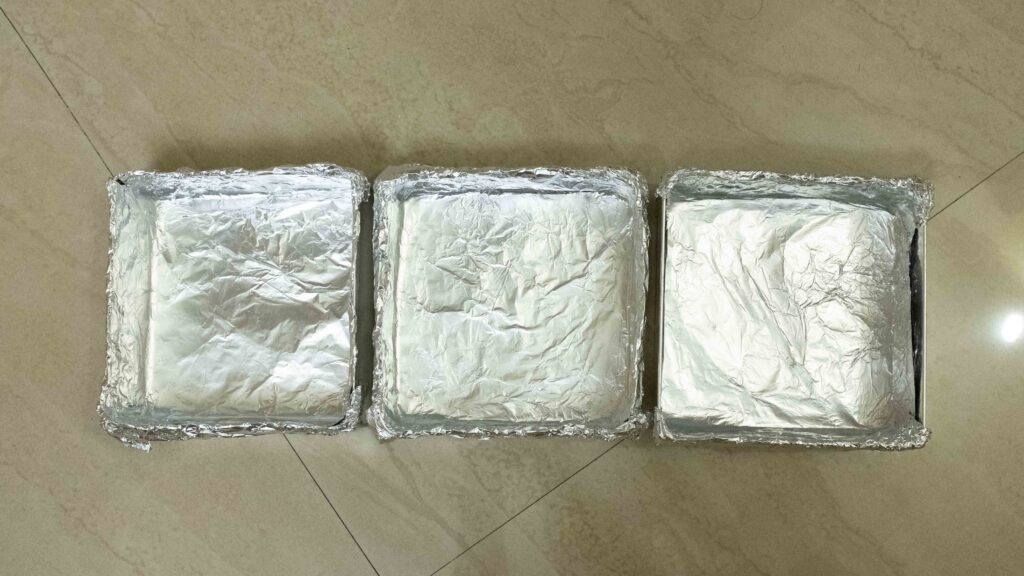
Method
for the rose-cashew sondesh:
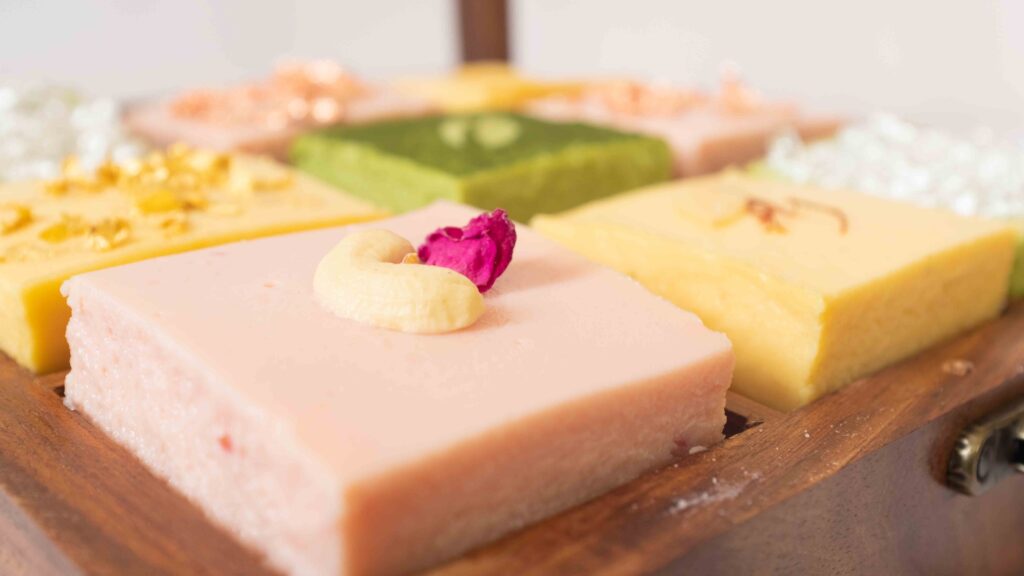
1 – Add the cottage cheese, cashews, heavy cream, sweetened condensed milk, rose syrup, and food colour to the jar of a blender. Blitz until very smooth and creamy, scraping down routinely and re-blitzing at least 3 times. You will end up with a thick, smooth, runny batter, tinted pastel pink.
2 – Pour the rose-cashew sondesh batter into the prepared cake pan. Lightly tap the pan on your counter to remove any air bubbles. Now cover the top of the cake pan with more aluminium foil, to fully seal it.
3 – Set a steamer pot on your stove. Add 1 litre of water and place a trivet or steamer basket inside. Once the water comes to a boil, lower your covered cake pan into the pot, making sure it’s not in contact with the water. Cover your steamer pot with its lid and lower the flame to minimum.
4 – Steam the rose-cashew sondesh on low heat for 20-25 minutes. To check for doneness, lift off the aluminium foil cover and gently touch the surface of the sondesh. If nothing transfers to your finger, it’s done.
5 – Remove the cake pan from the steamer basket, and immeditaly take off the aluminium foil cover. Cool to room temperature with the cover off.
6 – Once it’s cool to the touch, put the aluminium foil cover back on and place the pan inside the fridge to chill and set for 12 hours or overnight.
7 – After it’s fully set, take the pan out of the fridge and remove the aluminium foil cover. Now pull the aluminium mould out of the pan.
8 – Transfer your rectangle of rose-cashew sondesh to a plate or board, and peel back the aluminium mould from all sides. Using a very sharp knife, cut the rectangle into 8 equal pieces. Then each piece diagonally into 2 rectangles.
9 – Optional; decorate the tops of your rose-cashew sondesh with rose petals and/or edible rose gold flakes.
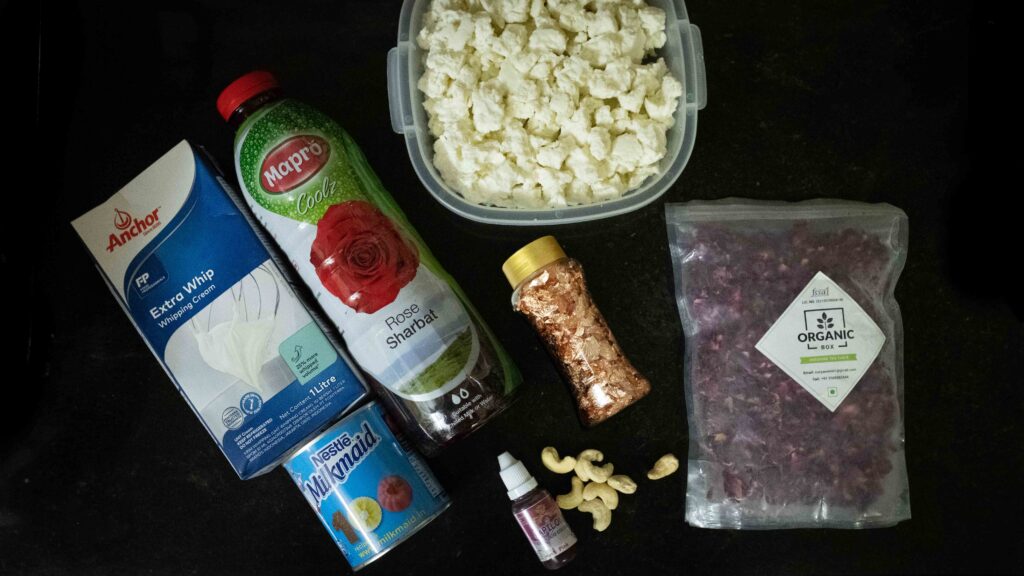
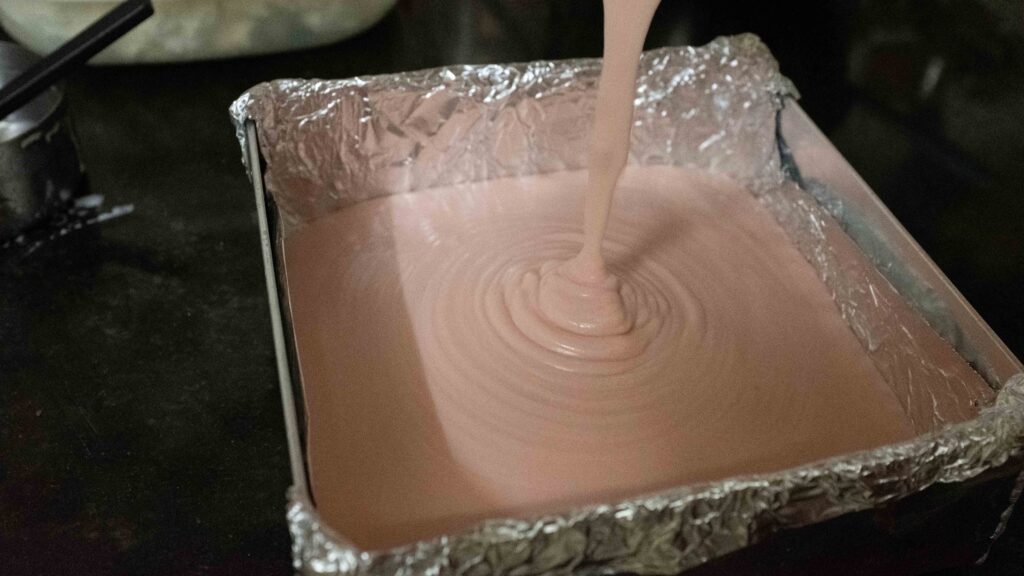
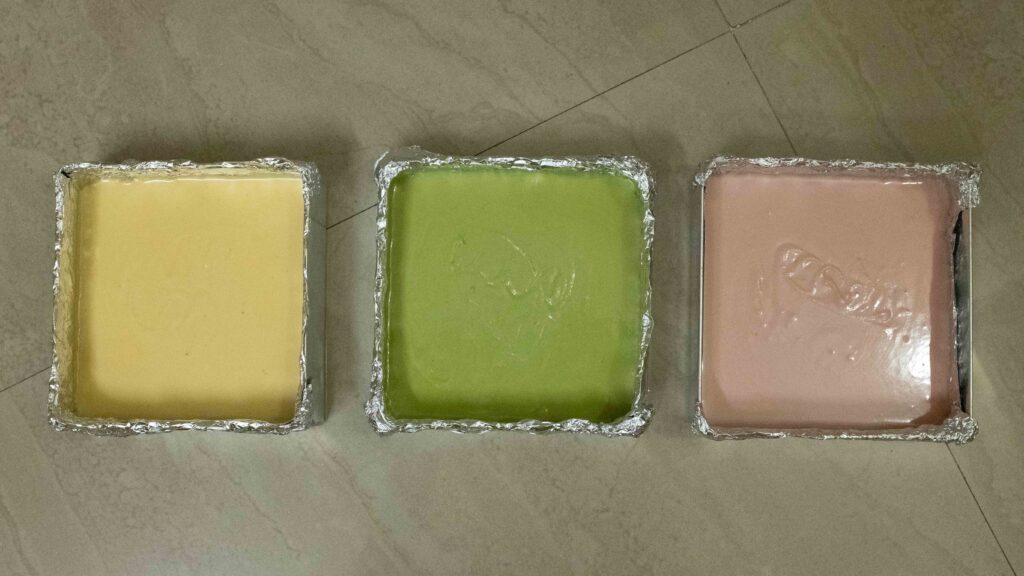
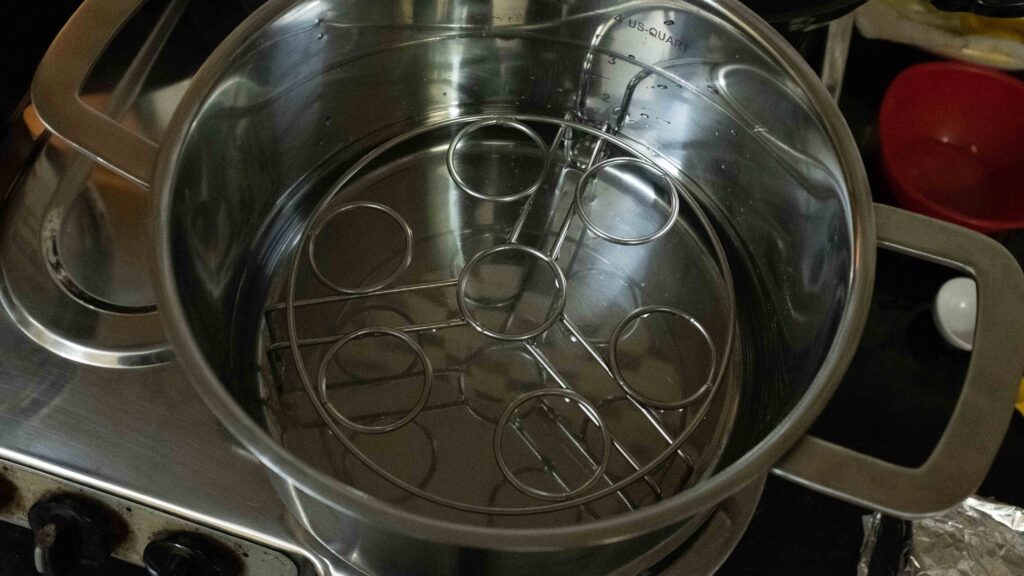
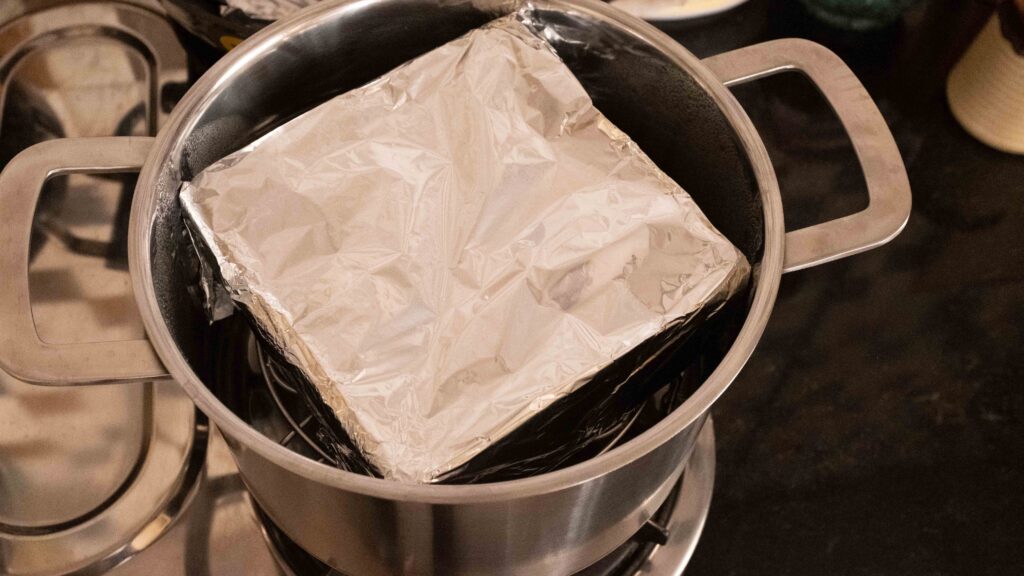

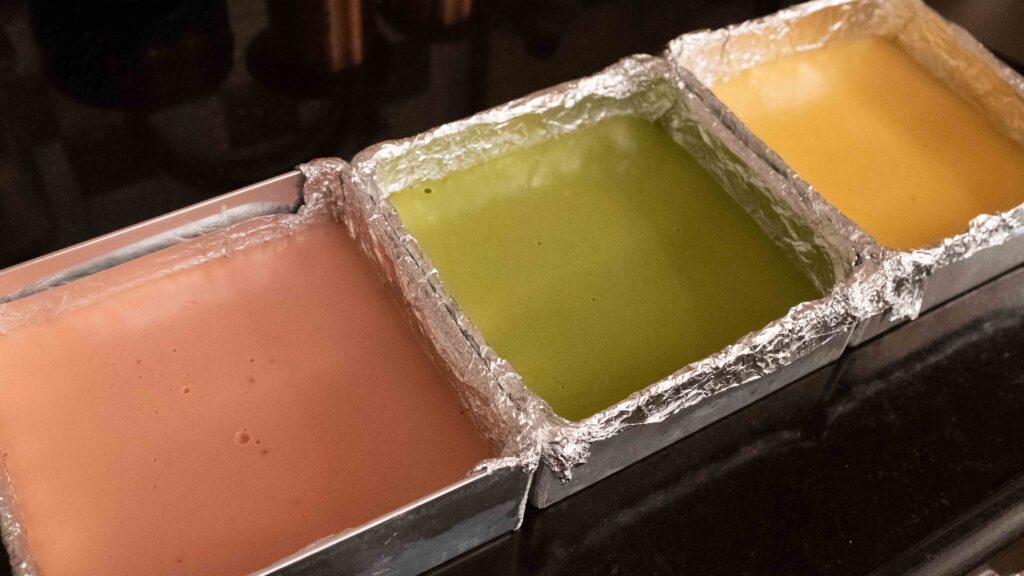
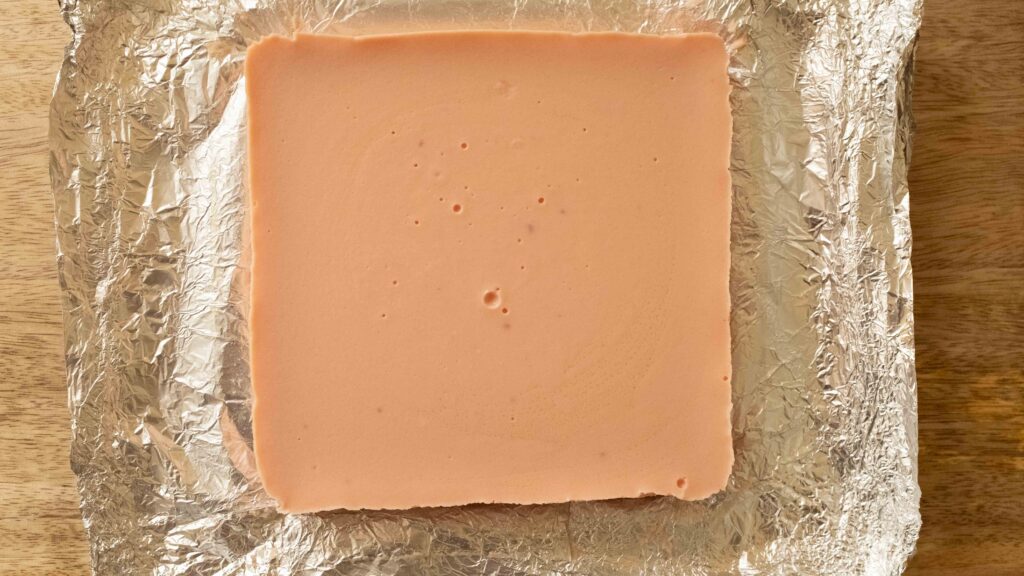
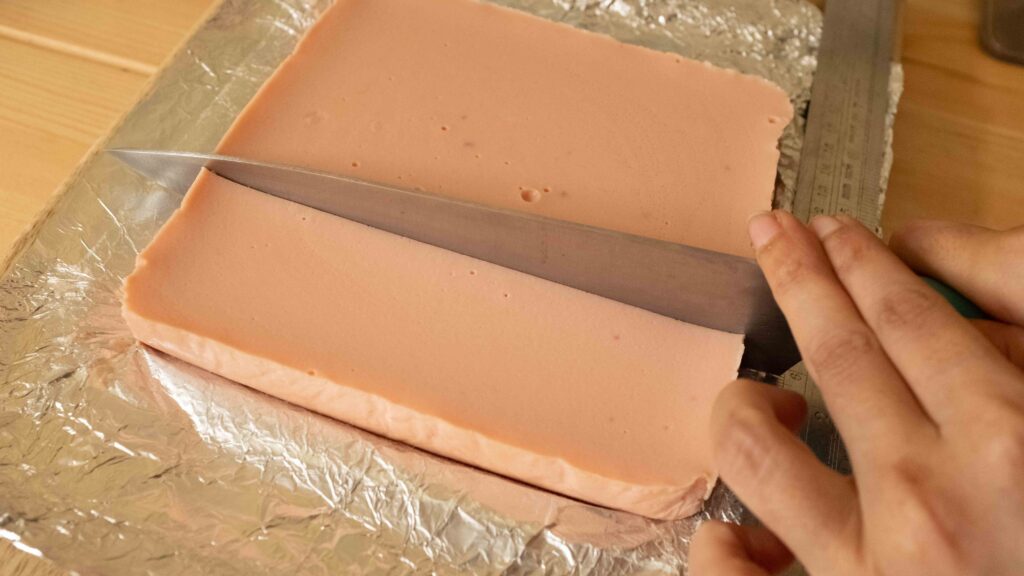
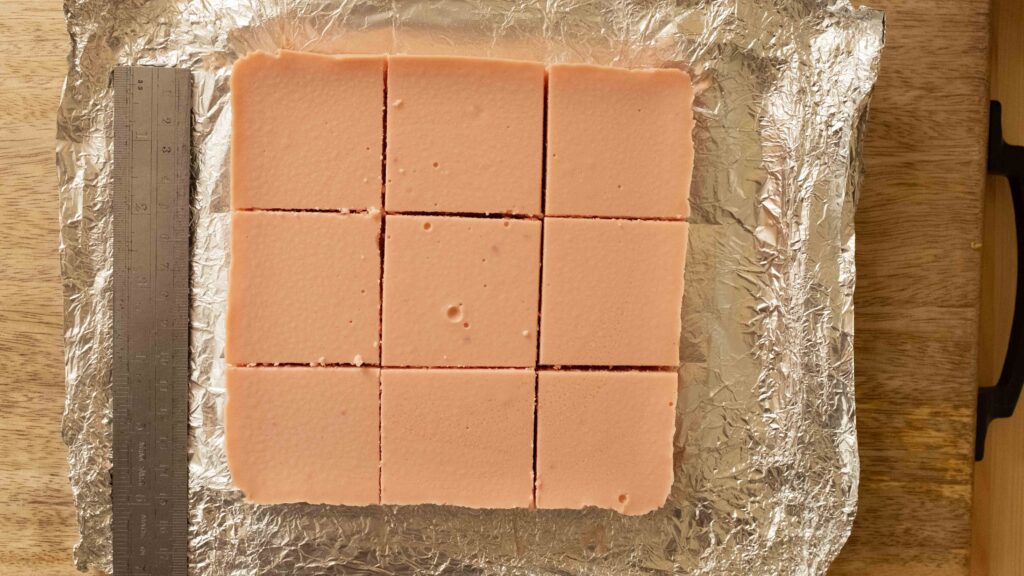
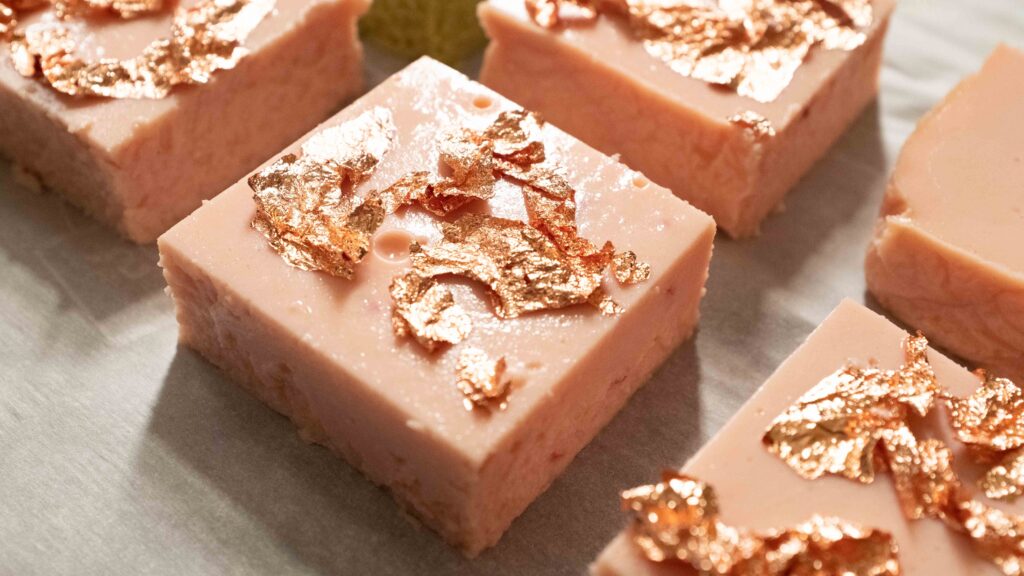
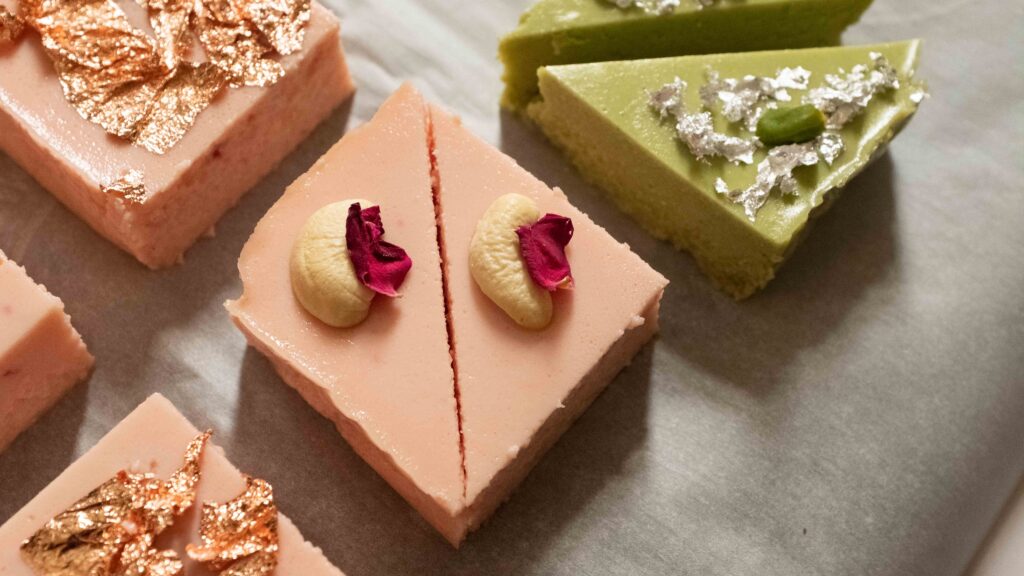
for the saffron-almond sondesh:
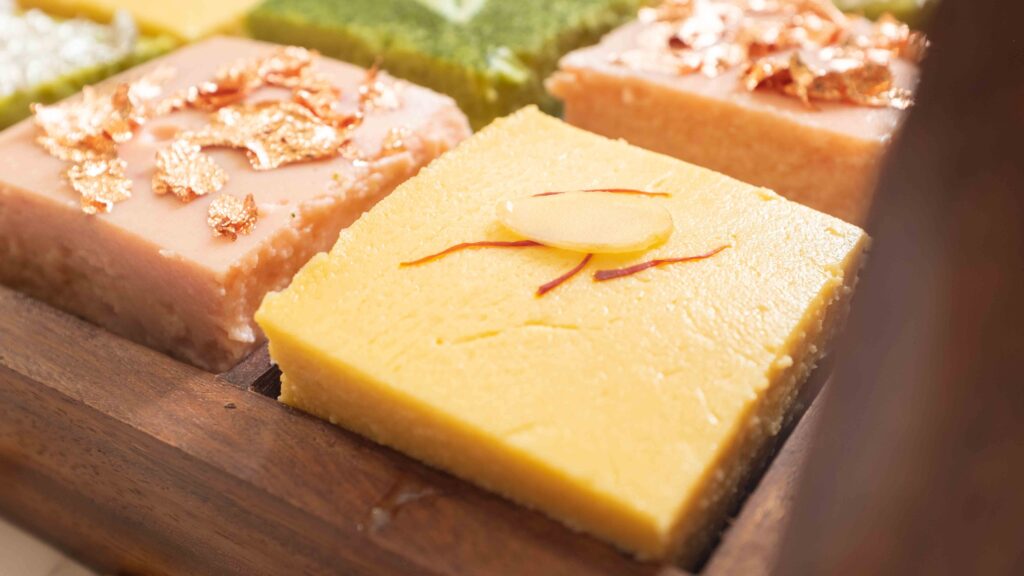
1 – Heat the milk in the microwave for 30 seconds. Place 10 saffron strands in the hot milk and leave to steep for 10 minutes.
2 – Add the cottage cheese, blanced almonds, heavy cream, sweetened condensed milk, the saffron infused milk, the cardamom powder, and the yellow food colour to the jar of a blender. Blitz until very smooth and creamy, scraping down routinely and re-blitzing at least 3 times. You will end up with a thick, smooth, runny batter, tinted pastel yellow.
3 – Pour the saffron-almond sondesh batter into the prepared cake pan. 2 – Pour the rose-cashew sondesh batter into the prepared cake pan. Lightly tap the pan on your counter to remove any air bubbles. Now cover the top of the cake pan with more aluminium foil, to fully seal it. Now cover the top of the cake pan with more aluminium foil, to fully seal it.
4 – Set a steamer pot on your stove. Add 1 litre of water and place a trivet or steamer basket inside. Once the water comes to a boil, lower your covered cake pan into the pot, making sure it’s not in contact with the water. Cover your steamer pot with its lid and lower the flame to minimum.
5 – Steam the saffron-almond sondesh on low heat for 20-25 minutes. To check for doneness, lift off the aluminium foil cover and gently touch the surface of the sondesh. If nothing transfers to your finger, it’s done.
6 – Remove the cake pan from the steamer basket, and immediately take off the aluminium foil cover. Cool to room temperature with the cover off.
7 – Once it’s cool to the touch, put the aluminium foil cover back on and place the pan inside the fridge to chill and set for 12 hours or overnight.
8 – After it’s fully set, take the pan out of the fridge and remove the aluminium foil cover. Now pull the aluminium mould out of the pan.
9 – Transfer your rectangle of saffron-almond sondesh to a plate or board, and peel back the aluminium mould from all sides. Using a very sharp knife, cut the rectangle into 8 equal pieces. Then each piece diagonally into 2 rectangles.
10 – Optional; decorate the tops of your saffron-almond sondesh with more saffron strands, sliced almonds and/or edible gold flakes.
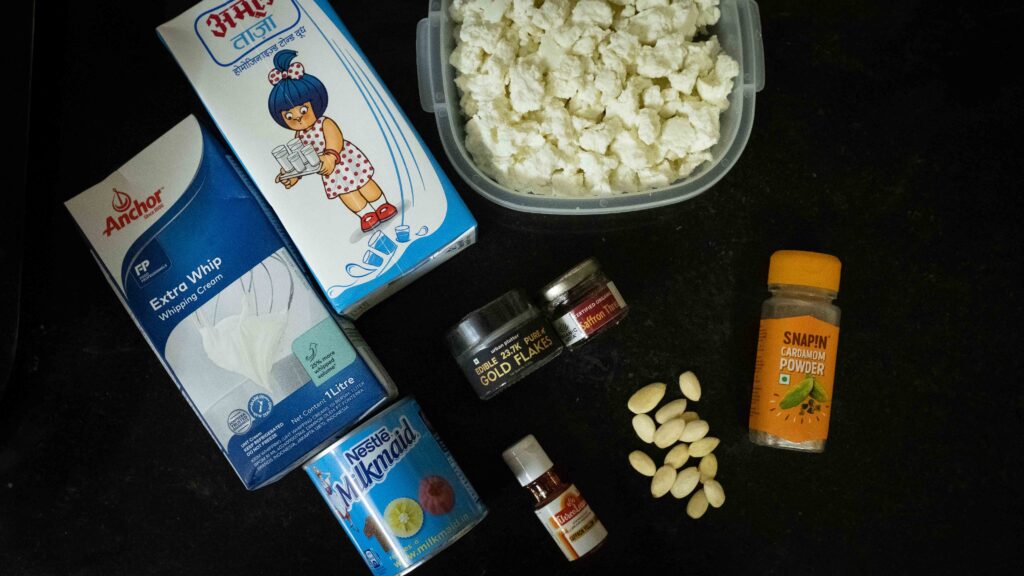
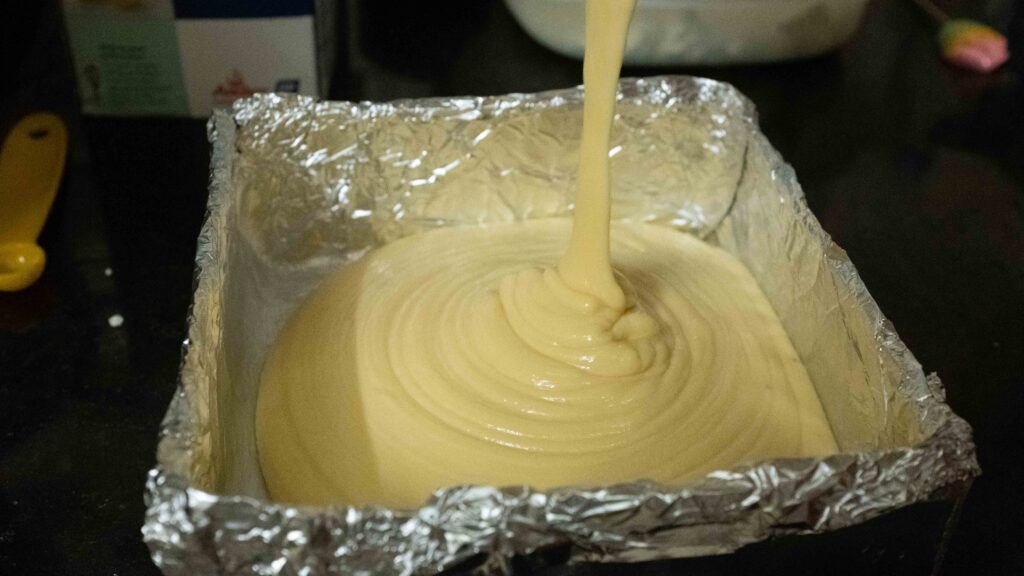





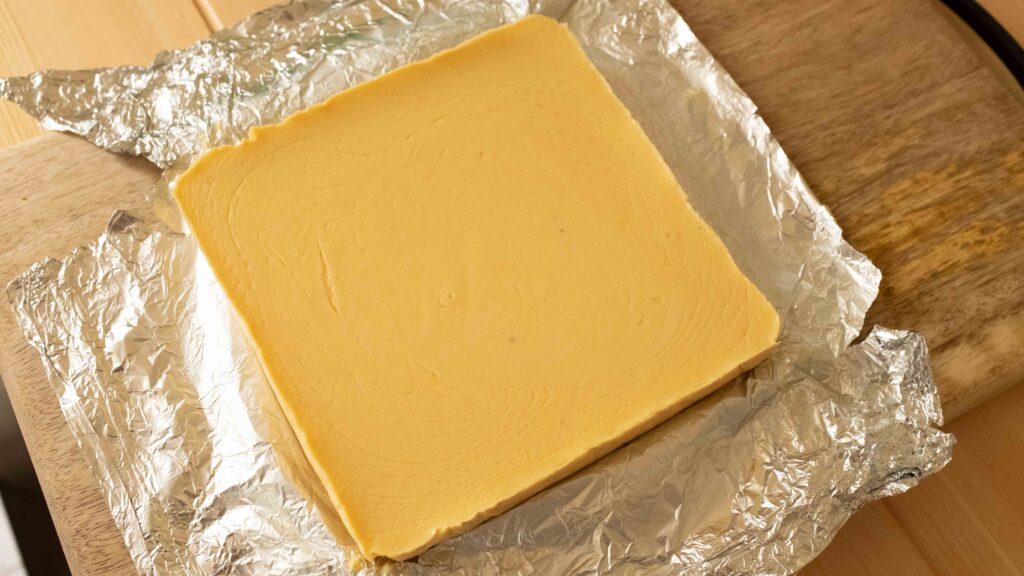
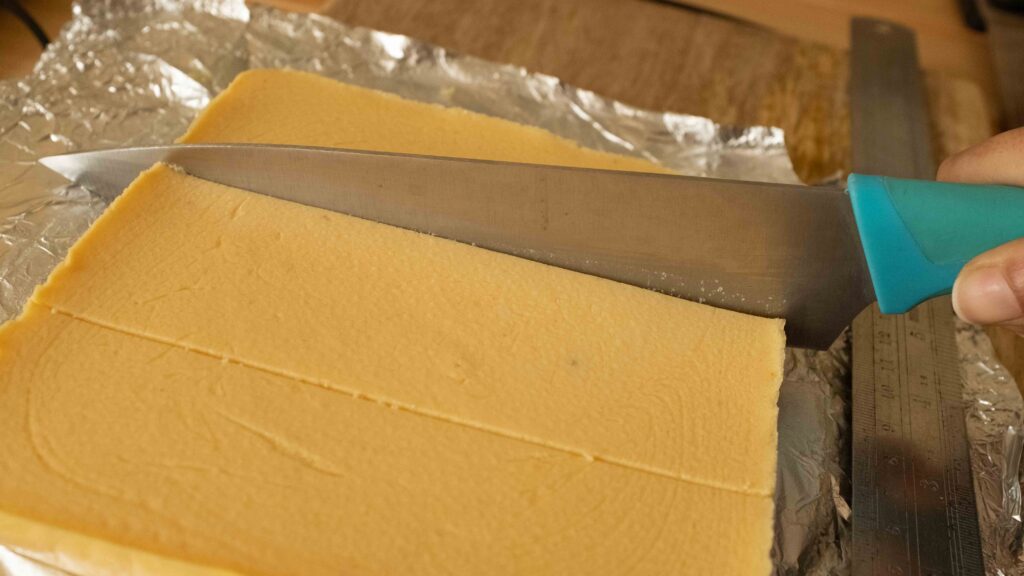
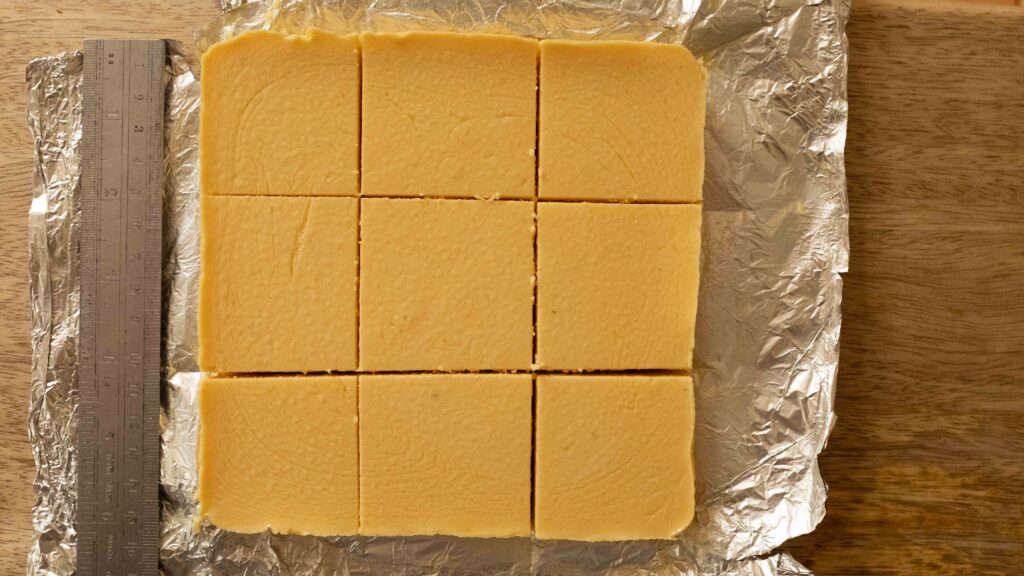
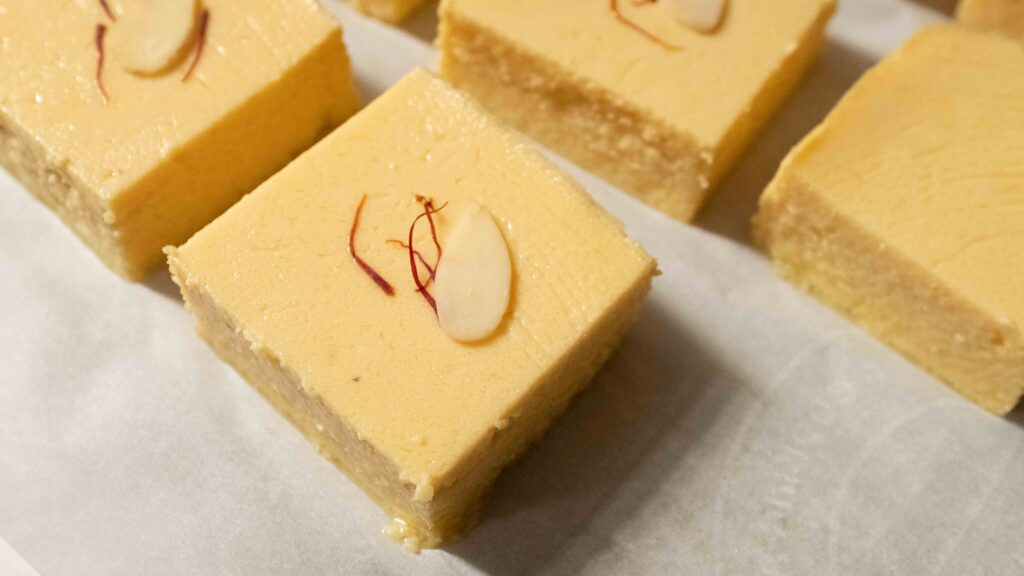
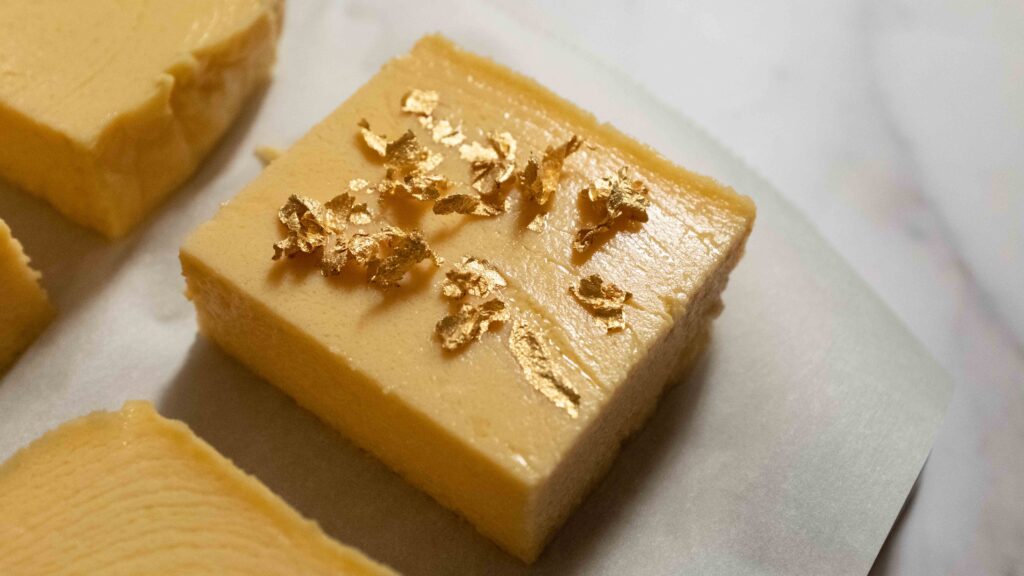
for the matcha-pista sondesh:
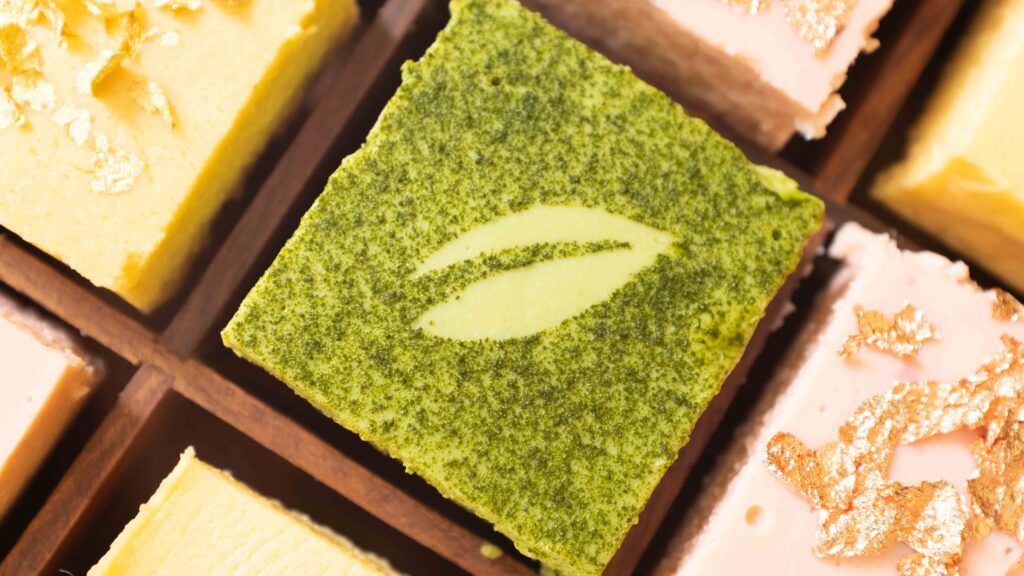
1 – Heat the milk in the microwave for 10 seconds. Mix the matcha powder with the milk and whisk to combine. It will become a thick paste.
2 – Add the cottage cheese, the blanched skinned pistachios, the heavy cream, the sweetened condensed milk, and the matcha paste to the jar of a blender. Blitz until very smooth and creamy, scraping down routinely and re-blitzing at least 3 times. You will end up with a thick, smooth, runny batter, tinted pastel green.
3 – Pour the matcha-pista sondesh batter into the prepared cake pan. 2 – Pour the rose-cashew sondesh batter into the prepared cake pan. Lightly tap the pan on your counter to remove any air bubbles. Now cover the top of the cake pan with more aluminium foil, to fully seal it. Now cover the top of the cake pan with more aluminium foil, to fully seal it.
4 – Set a steamer pot on your stove. Add 1 litre of water and place a trivet or steamer basket inside. Once the water comes to a boil, lower your covered cake pan into the pot, making sure it’s not in contact with the water. Cover your steamer pot with its lid and lower the flame to minimum.
5 – Steam the matcha-pista sondesh on low heat for 20-25 minutes. To check for doneness, lift off the aluminium foil cover and gently touch the surface of the sondesh. If nothing transfers to your finger, it’s done.
6 – Remove the cake pan from the steamer basket and immediately take off the aluminium foil cover. Cool to room temperature with the cover off.
7 – Once it’s cool to the touch, put the aluminium foil cover back on and place the pan inside the fridge to chill and set for 12 hours or overnight.
8 – After it’s fully set, take the pan out of the fridge and remove the aluminium foil cover. Now pull the aluminium mould out of the pan.
9 – Transfer your rectangle of matcha-pista sondesh to a plate or board, and peel back the aluminium mould from all sides. Using a very sharp knife, cut the rectangle into 8 equal pieces. Then each piece diagonally into 2 rectangles.
10 – Optional; decorate the tops of your matcha-pista sondesh with a dusting of matcha powder and finely chopped blanched pistachio/or edible silver flakes.
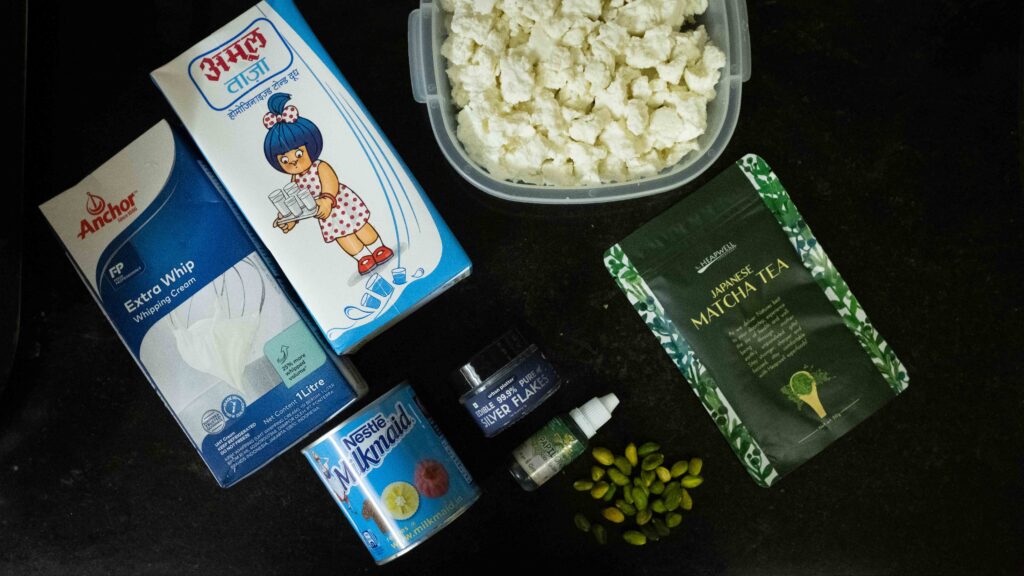
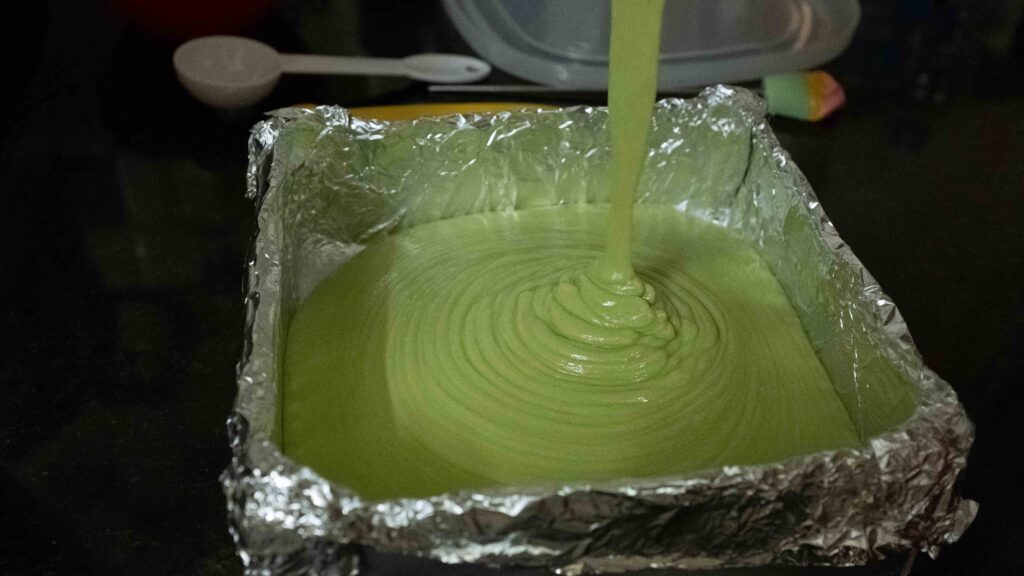





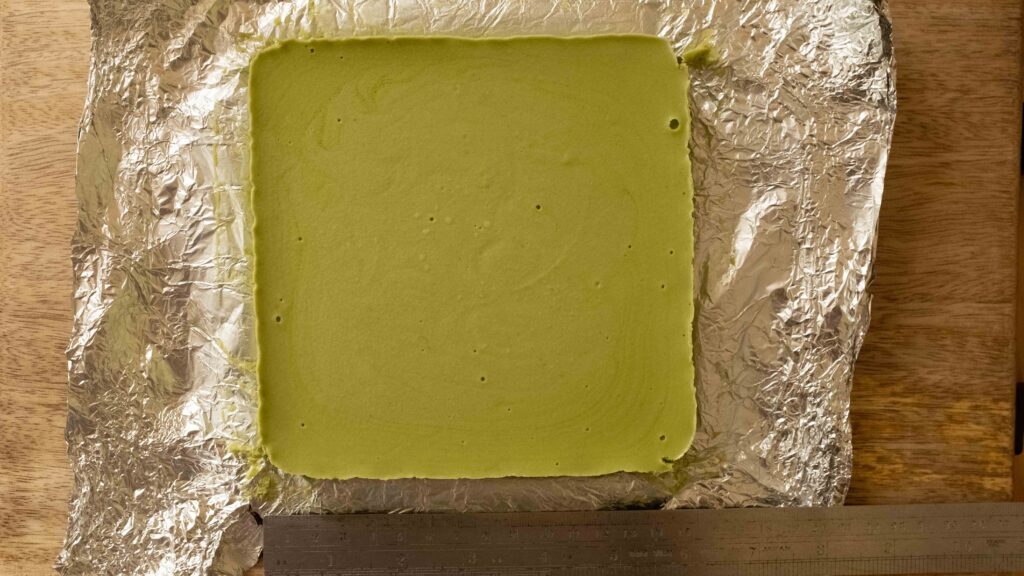
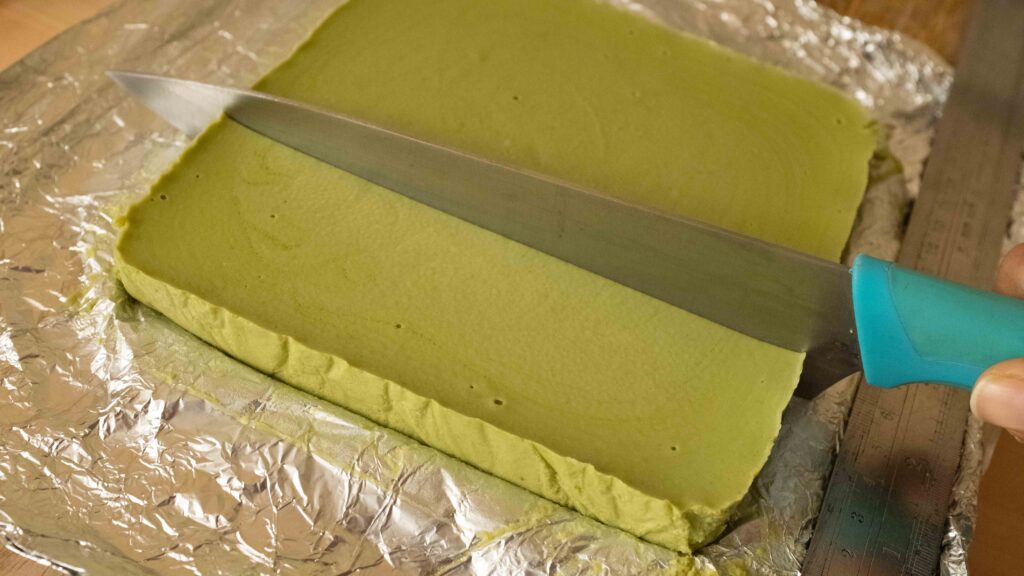
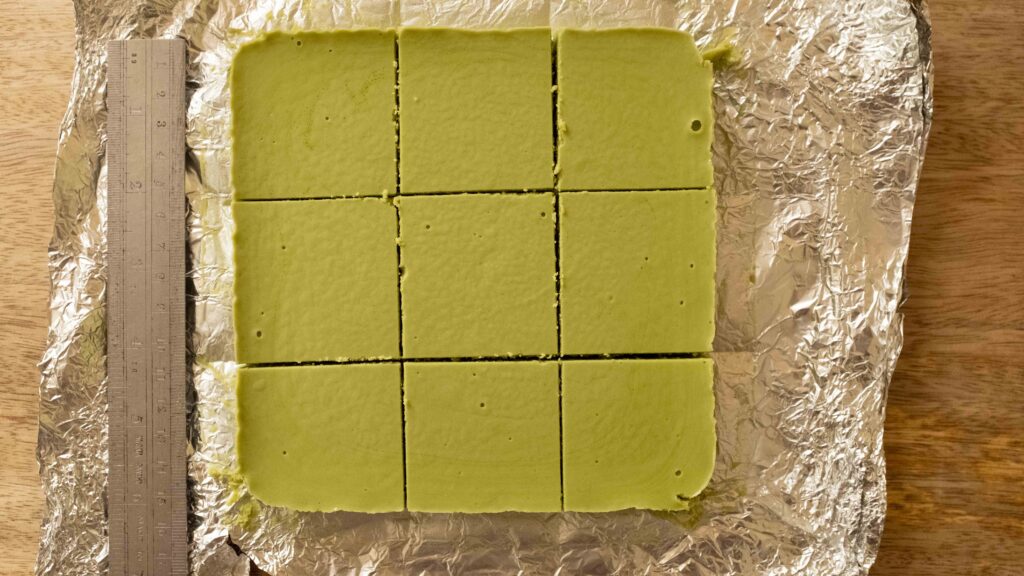
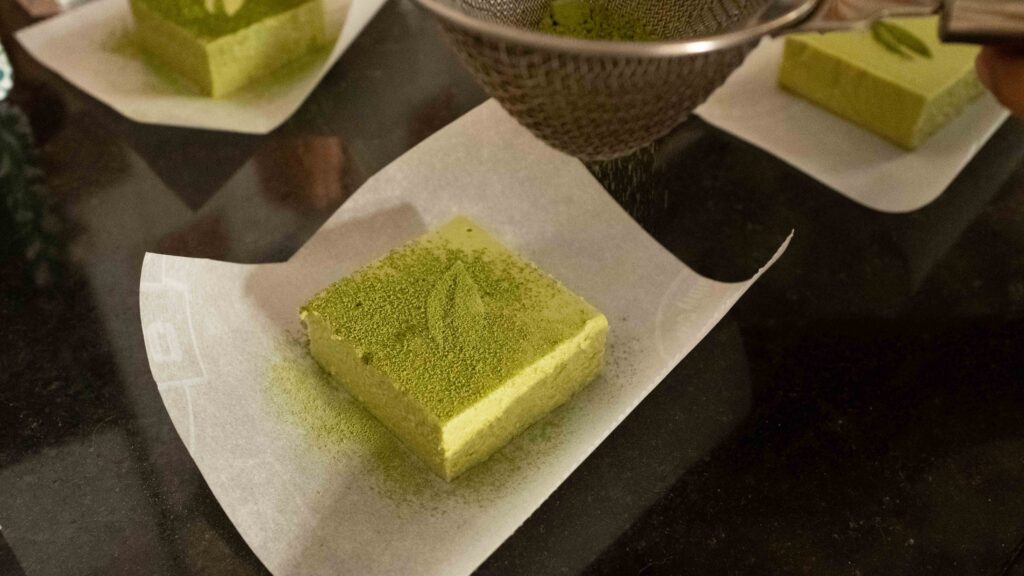

After the steaming step, refrigerate your sondesh only after it comes down to room temperature. Let it set in the fridge for at least 12 hours; do not attempt to unmould and cut it before that, else it will fall apart. If you would like to make only one type of sondesh, simply follow only that recipe. My rose-cashew sondesh took 25 minutes to steam, while the saffron-almond sondesh and the matcha-pista sondesh took only 20 minutes. I have no idea why! Check on your sondesh at the 20 minute mark and continue steaming only if needed.
Tips & Tricks
How to blanch almonds

